6 Alternatives to Amazon For E-commerce
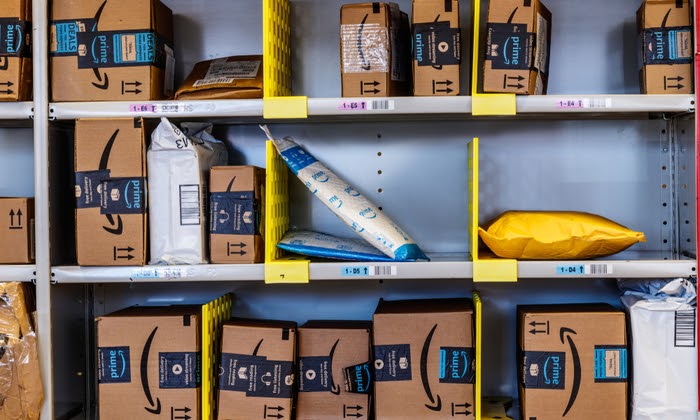
With a net worth of $1.7 trillion, Amazon has dominated the e-commerce sector for years, leaving many of its competitors in the shade. But are there alternatives to Amazon?
With an audience as vast as Amazon, small business start-ups and solo entrepreneurs flock to the site to sell the products, get established, and build their enterprises. Despite the audience Amazon offers, you may want to look for other online venues to list your items.
There are many good reasons to broaden your e-commerce horizons.
First, it makes little sense to put all your eggs in one basket. Second, selling on a wider range of marketplaces gets your products in front of a larger audience. And finally, looking at the other choices available could save you money on fees, or get you closer to your target buyers.
Below are some viable alternatives to Amazon. We’ll look at their advantages, their fee structures, and what makes them different.
Why You Should Use an Alternative to Amazon for Your E-commerce Business
We already touched on one of the main reasons to seek other venues: the perils of depending on one sales platform.
It’s not unheard of for sellers to have their accounts blocked. If you haven’t already established yourself on one of the alternatives to Amazon, your business could tank.
However, by setting up multiple accounts with different marketplaces, you’ve got greater flexibility if things go wrong. Plus, you can use other online platforms to test out which ones are the best for your products.
And there are other benefits in finding additional marketplaces, like:
Greater Flexibility
All e-commerce sales platforms have some measure of control over your business. They determine:
- What products you can list
- The terms and conditions of doing business
- Your payment options
- Shipping fees
These terms might not be suitable for your business. So, If you’re looking for greater flexibility, then seeking alternatives to Amazon is a good idea.
Better Customer and Vendor Support
Perhaps you feel the vendor or customer support is lacking. Amazon provides useful resources for sellers, like its university. But some sellers feel seller support is sometimes thin, especially when things go wrong.
More Shipping Options and Lower Fees With Some Amazon Alternatives
Amazon has changed its fee structure over the years, bringing frustration to some.
Amazon sets its professional selling plan at $39.99, with individual plans available free. And referral fees differ, depending on which category you’re selling in.
Shipping is a further reason to consider seeking alternatives as individual sellers on Amazon lack flexibility over their shipping costs.
If you’re looking to cut fees or branch out, then signing with some alternatives to Amazon may allow you to further scale your business while reducing costs.
Amazon Alternative Payment Choices
If you’re a seller on Amazon, you’ll know it makes payment via ACH or electronic funds transfer. Amazon distributes these payments to your bank account every two weeks, and they can take up to five days to clear.
But that doesn’t always work for everyone. If you’re a small business and cash is tight, signing up to e-commerce platforms with a broader range of payment options can improve your cash flow.
What to Look for in an Amazon Alternative
Before you search for alternatives to Amazon, you need to decide what you want from your business. You’ll need to consider the products you’re selling and your target customer, too.
For example, if you’re selling printable products, Etsy could be an excellent choice. Or, if you’re looking for consumers who understand tech, you may find Newegg works well for you.
Other areas you’ll want to think about include:
Ease of Use
Marketplaces that allow you to add items efficiently mean you can list more products in less time. But you’ll want to view any alternatives to Amazon from your customer’s perspective too.
How important is the ease of use? Well, if you note some recent research from Digital Commerce 360 and Bitrate, you’ll see this is a significant factor in the buying decision.
When researching new platforms, perhaps test them out for yourself and consider areas like:
- Navigation
- Ease of checkout
- Payment options
- Shipping choices
User Types
Think about your ideal consumer and the type of users the platform attracts. For example, eBay is huge, with 182 million active buyers. It’s great for snapping up limited-time deals, brand name products, and pre-loved items.
However, it’s not always the first place shoppers think of when looking for handmade goods or unique items. They’re more likely to head somewhere like Etsy.
Fees
Fees can take a considerable chunk of your profits if you’re not careful. Depending on the fee structure, some sites may not be suitable if you’re selling smaller, lower value items.
If you need some help in this area, fee calculators are helpful. Here’s a list of the well-known ones.
Best Alternatives to Amazon for E-commerce
What are some of the best Amazon alternatives when you’re looking to sell your products online? Let’s look at some of the top options, in no particular order.
Bonanza
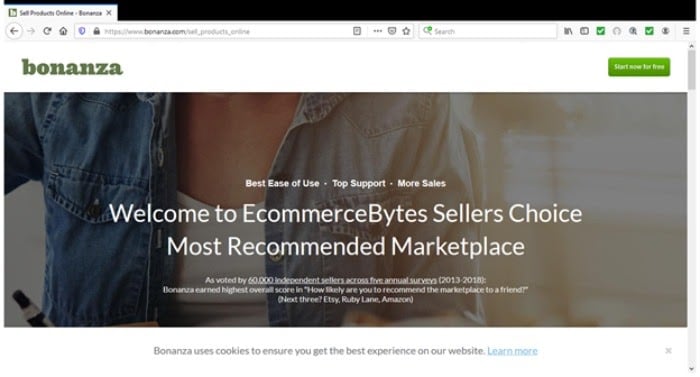
Established in 2007, Bonanza has built itself a loyal following, with a vast range of categories. Sign up is free, and fees are straight forward. Final offer value fees are 3.5 percent for sales under $500. Sales over $500 attract an additional 1.5 percent fee.
Although it’s much smaller than Amazon, Bonanza has some advantages over its larger rival. They include a greater emphasis on building customer relationships and developing a sustainable business through repeat customers.
Equally appealing to sellers is the marketing tools Bonanza provides. These give you access to valuable data about product performance, allowing you to spot trends, optimize listings, and better market your items.
Other features include:
- Automatic syncing with eBay, Amazon, and Shopify
- Customized marketing tools
- Image editing tools
- Google integration
- High level of customer support.
But what makes Bonanza stand out is its focus on unique items. It’s not trying to be another Amazon. As Bonanza puts it, it’s a site where you’ll find “everything but the ordinary”.
eBay
One of the most prominent alternatives to Amazon is eBay. Like Amazon, eBay has made considerable changes since its launch back in 1995. Over the years, eBay’s focus has moved away from the collectibles market it used to cater to, and it’s now more product-based.
Many famous brands like Rolex, Hasbro, and Microsoft make their goods available via ebay.com brand outlet site, enabling consumers to bag a bargain. But that doesn’t mean there isn’t still a place for more unusual or collectible items.
On eBay, listing fees and final value fees vary, but it sets many of its final value fees at 10 percent or less. If you need to calculate fees before listing, use an eBay fee calculator.
Some advantages of selling on eBay are:
- A more comprehensive range of categories
- More payment options for shoppers, like a credit/debit card, PayPal, and local collection. Sellers can also accept Apple Pay, Google Pay, and gift cards through managed payments.
- Improved branding through eBay stores and marketing materials
What makes eBay stand out, though, is its auctions. Auctions may not be ideal for every business. However, sellers who specialize in collectible or rare items may find the bidding pushes their final sales price up higher than they could’ve imagined.
Etsy
If your business primarily sells printable products or art and craft items, then Etsy might be for you. Of the many alternatives to Amazon, Etsy has perhaps one of the most affordable and straightforward pricing approaches.
Each listing costs just 20 cents, and the listing is good for four months. Then there’s a five percent transaction fee for goods that sell. Payment processing fees are variable and depend on location. If you want to grow your business further, Etsy Plus is available at $10 a month.
Re-listing is simple, too. Just select the auto-renew option, and there shouldn’t be anything else to do on your part.
Advantages of selling on Etsy are:
- Greater customization over how your store looks
- Ideal for beginners
- Lower fees
- Sellers can list collectibles and vintage items on Etsy
That’s the advantages, but there are a couple of possible disadvantages worth mentioning. First, Etsy is much smaller than Amazon, which means there’s intense competition, so your products need to stand out.
Second, although fees are cheaper, you may make more sales on Amazon Handmade because of its larger audience share.
Walmart Marketplace
Amazon dominates e-commerce, but Walmart is gaining ground. Recent sales figures show Walmart’s e-commerce sales have soared by 74 percent. This stat means if you’re looking for alternatives to Amazon, Walmart could be promising.
Like Amazon, Walmart now offers a fulfillment service. Although storage and fulfillment fees apply, Walmart’s fee structure is less complicated than Fulfillment by Amazon, and referral fees are competitive.
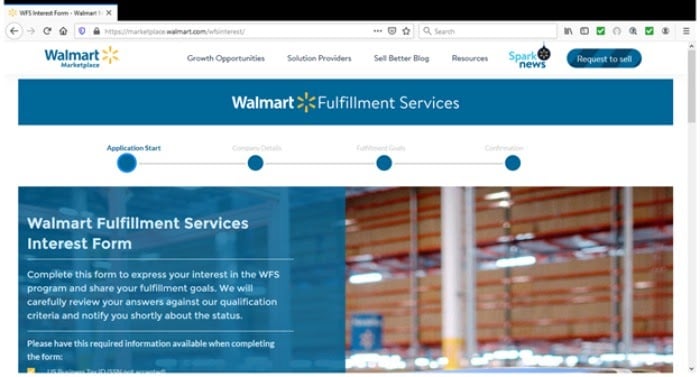
In addition, with Walmart’s marketplace, there’s no start-up or ongoing monthly fees. However, you’ll want to factor in other costs, like unique product codes (UPCs).
Advantages of selling on the Walmart marketplace include:
- Lower costs
- Less competition due to buyer/seller ratio
- Price control over inventory
What makes the platform different? Unlike Amazon, Walmart’s marketplace is only open to invited brands. You can’t just register and start selling. But you can sign up.
To register your interest in selling, Walmart asks businesses to fill out the interest form.
Newegg
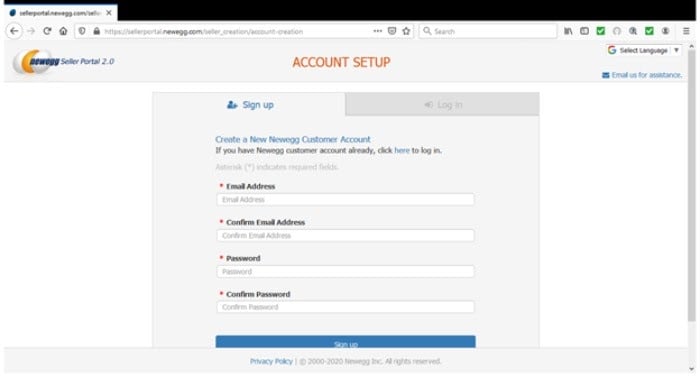
Newegg has gained a reputation as the top global tech marketplace online. But it also sells apparel, home and lifestyle products, sports/health-related items, TVs, and plenty more.
As for fees, non-elite membership is free. Elite membership has two tiers ranging from $29.95-$99.95 a month. Commissions vary, with the highest being 12 percent.
Advantages of selling on Newegg include:
- Can be cheaper for tech products
- Attracts tech buyers who are knowledgeable about products
- The Newegg search engine makes finding electronics and components quicker
- Customized marketing for businesses
- Various payment choices for sellers including weekly ACH payments, PayPal, Wire Transfer, PingPong, Payoneer, and World First
- A wide range of payments for buyers, including PayPal and BitPay
But it’s the multi-channel fulfillment option that may interest sellers the most. If you’re selling from various platforms, Newegg provides a central point to manage all your orders.
Shopify
When you sell on a third-party platform, you have limited control. Many online sellers favor setting up their stores the Shopify platform.
The site offers new sellers a 14-day free trial to get them started. After that, a basic Shopify store will cost you $29 a month. Online credit card rates are 2.9 percent + 30 cents. And you should find it easy enough to start selling.
Once you’ve signed up for the free trial, the next steps are to:
- Add products
- Selecting images
- Set shipping details
- Customize pages for search engines using keywords
- Create main pages
- Customize store
The benefits of Shopify include:
- Highly-rated customer support and selling features
- Greater customization
- Large range of e-commerce tools and apps
- Access to the e-commerce university
- You can accept a large range of currencies
Conclusion
There are a variety of reasons you might be looking for alternatives to Amazon. Maybe you want a platform that provides a wider range of payment options, a site that’s more niche, or you just want a more extensive selection of online marketplaces to sell your wares.
As you can see, there are many venues available, and they all have their advantages. Sites like Bonanza have established a loyal audience, and Walmart’s e-commerce presence is growing strong.
Niche sites such as Etsy and Newegg are ideal for specialist items, and eBay offers greater customization and various selling methods, including auctions.
If you want to go it alone, there’s always Shopify, where you can set up and market your own e-commerce business.
Are you an online seller? Tell us about your favorite platform and your experiences below.
The post 6 Alternatives to Amazon For E-commerce appeared first on Neil Patel.
6 Alternatives to Amazon For E-commerce

With a net worth of $1.7 trillion, Amazon has dominated the e-commerce sector for years, leaving many of its competitors in the shade. But are there alternatives to Amazon?
With an audience as vast as Amazon, small business start-ups and solo entrepreneurs flock to the site to sell the products, get established, and build their enterprises. Despite the audience Amazon offers, you may want to look for other online venues to list your items.
There are many good reasons to broaden your e-commerce horizons.
First, it makes little sense to put all your eggs in one basket. Second, selling on a wider range of marketplaces gets your products in front of a larger audience. And finally, looking at the other choices available could save you money on fees, or get you closer to your target buyers.
Below are some viable alternatives to Amazon. We’ll look at their advantages, their fee structures, and what makes them different.
Why You Should Use an Alternative to Amazon for Your E-commerce Business
We already touched on one of the main reasons to seek other venues: the perils of depending on one sales platform.
It’s not unheard of for sellers to have their accounts blocked. If you haven’t already established yourself on one of the alternatives to Amazon, your business could tank.
However, by setting up multiple accounts with different marketplaces, you’ve got greater flexibility if things go wrong. Plus, you can use other online platforms to test out which ones are the best for your products.
And there are other benefits in finding additional marketplaces, like:
Greater Flexibility
All e-commerce sales platforms have some measure of control over your business. They determine:
- What products you can list
- The terms and conditions of doing business
- Your payment options
- Shipping fees
These terms might not be suitable for your business. So, If you’re looking for greater flexibility, then seeking alternatives to Amazon is a good idea.
Better Customer and Vendor Support
Perhaps you feel the vendor or customer support is lacking. Amazon provides useful resources for sellers, like its university. But some sellers feel seller support is sometimes thin, especially when things go wrong.
More Shipping Options and Lower Fees With Some Amazon Alternatives
Amazon has changed its fee structure over the years, bringing frustration to some.
Amazon sets its professional selling plan at $39.99, with individual plans available free. And referral fees differ, depending on which category you’re selling in.
Shipping is a further reason to consider seeking alternatives as individual sellers on Amazon lack flexibility over their shipping costs.
If you’re looking to cut fees or branch out, then signing with some alternatives to Amazon may allow you to further scale your business while reducing costs.
Amazon Alternative Payment Choices
If you’re a seller on Amazon, you’ll know it makes payment via ACH or electronic funds transfer. Amazon distributes these payments to your bank account every two weeks, and they can take up to five days to clear.
But that doesn’t always work for everyone. If you’re a small business and cash is tight, signing up to e-commerce platforms with a broader range of payment options can improve your cash flow.
What to Look for in an Amazon Alternative
Before you search for alternatives to Amazon, you need to decide what you want from your business. You’ll need to consider the products you’re selling and your target customer, too.
For example, if you’re selling printable products, Etsy could be an excellent choice. Or, if you’re looking for consumers who understand tech, you may find Newegg works well for you.
Other areas you’ll want to think about include:
Ease of Use
Marketplaces that allow you to add items efficiently mean you can list more products in less time. But you’ll want to view any alternatives to Amazon from your customer’s perspective too.
How important is the ease of use? Well, if you note some recent research from Digital Commerce 360 and Bitrate, you’ll see this is a significant factor in the buying decision.
When researching new platforms, perhaps test them out for yourself and consider areas like:
- Navigation
- Ease of checkout
- Payment options
- Shipping choices
User Types
Think about your ideal consumer and the type of users the platform attracts. For example, eBay is huge, with 182 million active buyers. It’s great for snapping up limited-time deals, brand name products, and pre-loved items.
However, it’s not always the first place shoppers think of when looking for handmade goods or unique items. They’re more likely to head somewhere like Etsy.
Fees
Fees can take a considerable chunk of your profits if you’re not careful. Depending on the fee structure, some sites may not be suitable if you’re selling smaller, lower value items.
If you need some help in this area, fee calculators are helpful. Here’s a list of the well-known ones.
Best Alternatives to Amazon for E-commerce
What are some of the best Amazon alternatives when you’re looking to sell your products online? Let’s look at some of the top options, in no particular order.
Bonanza

Established in 2007, Bonanza has built itself a loyal following, with a vast range of categories. Sign up is free, and fees are straight forward. Final offer value fees are 3.5 percent for sales under $500. Sales over $500 attract an additional 1.5 percent fee.
Although it’s much smaller than Amazon, Bonanza has some advantages over its larger rival. They include a greater emphasis on building customer relationships and developing a sustainable business through repeat customers.
Equally appealing to sellers is the marketing tools Bonanza provides. These give you access to valuable data about product performance, allowing you to spot trends, optimize listings, and better market your items.
Other features include:
- Automatic syncing with eBay, Amazon, and Shopify
- Customized marketing tools
- Image editing tools
- Google integration
- High level of customer support.
But what makes Bonanza stand out is its focus on unique items. It’s not trying to be another Amazon. As Bonanza puts it, it’s a site where you’ll find “everything but the ordinary”.
eBay
One of the most prominent alternatives to Amazon is eBay. Like Amazon, eBay has made considerable changes since its launch back in 1995. Over the years, eBay’s focus has moved away from the collectibles market it used to cater to, and it’s now more product-based.
Many famous brands like Rolex, Hasbro, and Microsoft make their goods available via ebay.com brand outlet site, enabling consumers to bag a bargain. But that doesn’t mean there isn’t still a place for more unusual or collectible items.
On eBay, listing fees and final value fees vary, but it sets many of its final value fees at 10 percent or less. If you need to calculate fees before listing, use an eBay fee calculator.
Some advantages of selling on eBay are:
- A more comprehensive range of categories
- More payment options for shoppers, like a credit/debit card, PayPal, and local collection. Sellers can also accept Apple Pay, Google Pay, and gift cards through managed payments.
- Improved branding through eBay stores and marketing materials
What makes eBay stand out, though, is its auctions. Auctions may not be ideal for every business. However, sellers who specialize in collectible or rare items may find the bidding pushes their final sales price up higher than they could’ve imagined.
Etsy
If your business primarily sells printable products or art and craft items, then Etsy might be for you. Of the many alternatives to Amazon, Etsy has perhaps one of the most affordable and straightforward pricing approaches.
Each listing costs just 20 cents, and the listing is good for four months. Then there’s a five percent transaction fee for goods that sell. Payment processing fees are variable and depend on location. If you want to grow your business further, Etsy Plus is available at $10 a month.
Re-listing is simple, too. Just select the auto-renew option, and there shouldn’t be anything else to do on your part.
Advantages of selling on Etsy are:
- Greater customization over how your store looks
- Ideal for beginners
- Lower fees
- Sellers can list collectibles and vintage items on Etsy
That’s the advantages, but there are a couple of possible disadvantages worth mentioning. First, Etsy is much smaller than Amazon, which means there’s intense competition, so your products need to stand out.
Second, although fees are cheaper, you may make more sales on Amazon Handmade because of its larger audience share.
Walmart Marketplace
Amazon dominates e-commerce, but Walmart is gaining ground. Recent sales figures show Walmart’s e-commerce sales have soared by 74 percent. This stat means if you’re looking for alternatives to Amazon, Walmart could be promising.
Like Amazon, Walmart now offers a fulfillment service. Although storage and fulfillment fees apply, Walmart’s fee structure is less complicated than Fulfillment by Amazon, and referral fees are competitive.

In addition, with Walmart’s marketplace, there’s no start-up or ongoing monthly fees. However, you’ll want to factor in other costs, like unique product codes (UPCs).
Advantages of selling on the Walmart marketplace include:
- Lower costs
- Less competition due to buyer/seller ratio
- Price control over inventory
What makes the platform different? Unlike Amazon, Walmart’s marketplace is only open to invited brands. You can’t just register and start selling. But you can sign up.
To register your interest in selling, Walmart asks businesses to fill out the interest form.
Newegg

Newegg has gained a reputation as the top global tech marketplace online. But it also sells apparel, home and lifestyle products, sports/health-related items, TVs, and plenty more.
As for fees, non-elite membership is free. Elite membership has two tiers ranging from $29.95-$99.95 a month. Commissions vary, with the highest being 12 percent.
Advantages of selling on Newegg include:
- Can be cheaper for tech products
- Attracts tech buyers who are knowledgeable about products
- The Newegg search engine makes finding electronics and components quicker
- Customized marketing for businesses
- Various payment choices for sellers including weekly ACH payments, PayPal, Wire Transfer, PingPong, Payoneer, and World First
- A wide range of payments for buyers, including PayPal and BitPay
But it’s the multi-channel fulfillment option that may interest sellers the most. If you’re selling from various platforms, Newegg provides a central point to manage all your orders.
Shopify
When you sell on a third-party platform, you have limited control. Many online sellers favor setting up their stores the Shopify platform.
The site offers new sellers a 14-day free trial to get them started. After that, a basic Shopify store will cost you $29 a month. Online credit card rates are 2.9 percent + 30 cents. And you should find it easy enough to start selling.
Once you’ve signed up for the free trial, the next steps are to:
- Add products
- Selecting images
- Set shipping details
- Customize pages for search engines using keywords
- Create main pages
- Customize store
The benefits of Shopify include:
- Highly-rated customer support and selling features
- Greater customization
- Large range of e-commerce tools and apps
- Access to the e-commerce university
- You can accept a large range of currencies
Conclusion
There are a variety of reasons you might be looking for alternatives to Amazon. Maybe you want a platform that provides a wider range of payment options, a site that’s more niche, or you just want a more extensive selection of online marketplaces to sell your wares.
As you can see, there are many venues available, and they all have their advantages. Sites like Bonanza have established a loyal audience, and Walmart’s e-commerce presence is growing strong.
Niche sites such as Etsy and Newegg are ideal for specialist items, and eBay offers greater customization and various selling methods, including auctions.
If you want to go it alone, there’s always Shopify, where you can set up and market your own e-commerce business.
Are you an online seller? Tell us about your favorite platform and your experiences below.
The post 6 Alternatives to Amazon For E-commerce appeared first on Neil Patel.
6 Alternatives to Amazon For E-commerce

With a net worth of $1.7 trillion, Amazon has dominated the e-commerce sector for years, leaving many of its competitors in the shade. But are there alternatives to Amazon?
With an audience as vast as Amazon, small business start-ups and solo entrepreneurs flock to the site to sell the products, get established, and build their enterprises. Despite the audience Amazon offers, you may want to look for other online venues to list your items.
There are many good reasons to broaden your e-commerce horizons.
First, it makes little sense to put all your eggs in one basket. Second, selling on a wider range of marketplaces gets your products in front of a larger audience. And finally, looking at the other choices available could save you money on fees, or get you closer to your target buyers.
Below are some viable alternatives to Amazon. We’ll look at their advantages, their fee structures, and what makes them different.
Why You Should Use an Alternative to Amazon for Your E-commerce Business
We already touched on one of the main reasons to seek other venues: the perils of depending on one sales platform.
It’s not unheard of for sellers to have their accounts blocked. If you haven’t already established yourself on one of the alternatives to Amazon, your business could tank.
However, by setting up multiple accounts with different marketplaces, you’ve got greater flexibility if things go wrong. Plus, you can use other online platforms to test out which ones are the best for your products.
And there are other benefits in finding additional marketplaces, like:
Greater Flexibility
All e-commerce sales platforms have some measure of control over your business. They determine:
- What products you can list
- The terms and conditions of doing business
- Your payment options
- Shipping fees
These terms might not be suitable for your business. So, If you’re looking for greater flexibility, then seeking alternatives to Amazon is a good idea.
Better Customer and Vendor Support
Perhaps you feel the vendor or customer support is lacking. Amazon provides useful resources for sellers, like its university. But some sellers feel seller support is sometimes thin, especially when things go wrong.
More Shipping Options and Lower Fees With Some Amazon Alternatives
Amazon has changed its fee structure over the years, bringing frustration to some.
Amazon sets its professional selling plan at $39.99, with individual plans available free. And referral fees differ, depending on which category you’re selling in.
Shipping is a further reason to consider seeking alternatives as individual sellers on Amazon lack flexibility over their shipping costs.
If you’re looking to cut fees or branch out, then signing with some alternatives to Amazon may allow you to further scale your business while reducing costs.
Amazon Alternative Payment Choices
If you’re a seller on Amazon, you’ll know it makes payment via ACH or electronic funds transfer. Amazon distributes these payments to your bank account every two weeks, and they can take up to five days to clear.
But that doesn’t always work for everyone. If you’re a small business and cash is tight, signing up to e-commerce platforms with a broader range of payment options can improve your cash flow.
What to Look for in an Amazon Alternative
Before you search for alternatives to Amazon, you need to decide what you want from your business. You’ll need to consider the products you’re selling and your target customer, too.
For example, if you’re selling printable products, Etsy could be an excellent choice. Or, if you’re looking for consumers who understand tech, you may find Newegg works well for you.
Other areas you’ll want to think about include:
Ease of Use
Marketplaces that allow you to add items efficiently mean you can list more products in less time. But you’ll want to view any alternatives to Amazon from your customer’s perspective too.
How important is the ease of use? Well, if you note some recent research from Digital Commerce 360 and Bitrate, you’ll see this is a significant factor in the buying decision.
When researching new platforms, perhaps test them out for yourself and consider areas like:
- Navigation
- Ease of checkout
- Payment options
- Shipping choices
User Types
Think about your ideal consumer and the type of users the platform attracts. For example, eBay is huge, with 182 million active buyers. It’s great for snapping up limited-time deals, brand name products, and pre-loved items.
However, it’s not always the first place shoppers think of when looking for handmade goods or unique items. They’re more likely to head somewhere like Etsy.
Fees
Fees can take a considerable chunk of your profits if you’re not careful. Depending on the fee structure, some sites may not be suitable if you’re selling smaller, lower value items.
If you need some help in this area, fee calculators are helpful. Here’s a list of the well-known ones.
Best Alternatives to Amazon for E-commerce
What are some of the best Amazon alternatives when you’re looking to sell your products online? Let’s look at some of the top options, in no particular order.
Bonanza

Established in 2007, Bonanza has built itself a loyal following, with a vast range of categories. Sign up is free, and fees are straight forward. Final offer value fees are 3.5 percent for sales under $500. Sales over $500 attract an additional 1.5 percent fee.
Although it’s much smaller than Amazon, Bonanza has some advantages over its larger rival. They include a greater emphasis on building customer relationships and developing a sustainable business through repeat customers.
Equally appealing to sellers is the marketing tools Bonanza provides. These give you access to valuable data about product performance, allowing you to spot trends, optimize listings, and better market your items.
Other features include:
- Automatic syncing with eBay, Amazon, and Shopify
- Customized marketing tools
- Image editing tools
- Google integration
- High level of customer support.
But what makes Bonanza stand out is its focus on unique items. It’s not trying to be another Amazon. As Bonanza puts it, it’s a site where you’ll find “everything but the ordinary”.
eBay
One of the most prominent alternatives to Amazon is eBay. Like Amazon, eBay has made considerable changes since its launch back in 1995. Over the years, eBay’s focus has moved away from the collectibles market it used to cater to, and it’s now more product-based.
Many famous brands like Rolex, Hasbro, and Microsoft make their goods available via ebay.com brand outlet site, enabling consumers to bag a bargain. But that doesn’t mean there isn’t still a place for more unusual or collectible items.
On eBay, listing fees and final value fees vary, but it sets many of its final value fees at 10 percent or less. If you need to calculate fees before listing, use an eBay fee calculator.
Some advantages of selling on eBay are:
- A more comprehensive range of categories
- More payment options for shoppers, like a credit/debit card, PayPal, and local collection. Sellers can also accept Apple Pay, Google Pay, and gift cards through managed payments.
- Improved branding through eBay stores and marketing materials
What makes eBay stand out, though, is its auctions. Auctions may not be ideal for every business. However, sellers who specialize in collectible or rare items may find the bidding pushes their final sales price up higher than they could’ve imagined.
Etsy
If your business primarily sells printable products or art and craft items, then Etsy might be for you. Of the many alternatives to Amazon, Etsy has perhaps one of the most affordable and straightforward pricing approaches.
Each listing costs just 20 cents, and the listing is good for four months. Then there’s a five percent transaction fee for goods that sell. Payment processing fees are variable and depend on location. If you want to grow your business further, Etsy Plus is available at $10 a month.
Re-listing is simple, too. Just select the auto-renew option, and there shouldn’t be anything else to do on your part.
Advantages of selling on Etsy are:
- Greater customization over how your store looks
- Ideal for beginners
- Lower fees
- Sellers can list collectibles and vintage items on Etsy
That’s the advantages, but there are a couple of possible disadvantages worth mentioning. First, Etsy is much smaller than Amazon, which means there’s intense competition, so your products need to stand out.
Second, although fees are cheaper, you may make more sales on Amazon Handmade because of its larger audience share.
Walmart Marketplace
Amazon dominates e-commerce, but Walmart is gaining ground. Recent sales figures show Walmart’s e-commerce sales have soared by 74 percent. This stat means if you’re looking for alternatives to Amazon, Walmart could be promising.
Like Amazon, Walmart now offers a fulfillment service. Although storage and fulfillment fees apply, Walmart’s fee structure is less complicated than Fulfillment by Amazon, and referral fees are competitive.

In addition, with Walmart’s marketplace, there’s no start-up or ongoing monthly fees. However, you’ll want to factor in other costs, like unique product codes (UPCs).
Advantages of selling on the Walmart marketplace include:
- Lower costs
- Less competition due to buyer/seller ratio
- Price control over inventory
What makes the platform different? Unlike Amazon, Walmart’s marketplace is only open to invited brands. You can’t just register and start selling. But you can sign up.
To register your interest in selling, Walmart asks businesses to fill out the interest form.
Newegg

Newegg has gained a reputation as the top global tech marketplace online. But it also sells apparel, home and lifestyle products, sports/health-related items, TVs, and plenty more.
As for fees, non-elite membership is free. Elite membership has two tiers ranging from $29.95-$99.95 a month. Commissions vary, with the highest being 12 percent.
Advantages of selling on Newegg include:
- Can be cheaper for tech products
- Attracts tech buyers who are knowledgeable about products
- The Newegg search engine makes finding electronics and components quicker
- Customized marketing for businesses
- Various payment choices for sellers including weekly ACH payments, PayPal, Wire Transfer, PingPong, Payoneer, and World First
- A wide range of payments for buyers, including PayPal and BitPay
But it’s the multi-channel fulfillment option that may interest sellers the most. If you’re selling from various platforms, Newegg provides a central point to manage all your orders.
Shopify
When you sell on a third-party platform, you have limited control. Many online sellers favor setting up their stores the Shopify platform.
The site offers new sellers a 14-day free trial to get them started. After that, a basic Shopify store will cost you $29 a month. Online credit card rates are 2.9 percent + 30 cents. And you should find it easy enough to start selling.
Once you’ve signed up for the free trial, the next steps are to:
- Add products
- Selecting images
- Set shipping details
- Customize pages for search engines using keywords
- Create main pages
- Customize store
The benefits of Shopify include:
- Highly-rated customer support and selling features
- Greater customization
- Large range of e-commerce tools and apps
- Access to the e-commerce university
- You can accept a large range of currencies
Conclusion
There are a variety of reasons you might be looking for alternatives to Amazon. Maybe you want a platform that provides a wider range of payment options, a site that’s more niche, or you just want a more extensive selection of online marketplaces to sell your wares.
As you can see, there are many venues available, and they all have their advantages. Sites like Bonanza have established a loyal audience, and Walmart’s e-commerce presence is growing strong.
Niche sites such as Etsy and Newegg are ideal for specialist items, and eBay offers greater customization and various selling methods, including auctions.
If you want to go it alone, there’s always Shopify, where you can set up and market your own e-commerce business.
Are you an online seller? Tell us about your favorite platform and your experiences below.
The post 6 Alternatives to Amazon For E-commerce appeared first on Neil Patel.
The Best Luxury Marketing Strategies

Have you ever seen a Facebook ad for Chanel? Or an Instagram ad for Lamborghini?
Me neither. That’s because luxury marketing strategies don’t follow the same rules as mass-market brands.
Selling to high-end consumers requires a different approach. But that doesn’t mean popular digital channels are off-limits.
SEO, PPC, even some social media sites can drive online sales for your luxury brand.
Today, I’m going to show you exactly how to take your luxury brand online with the best luxury marketing strategies.
What Qualifies as a Luxury Brand?
Gucci, Rolex, Ferrari. For the most part, you know luxury brands when you hear them.
But what does it take for a brand to qualify as a luxury? In my opinion, it’s down to the three Es: Expensive, Excellent, and Exclusive.
Luxury products are synonymous with high price tags. This is the most common indicator of luxury, but it is also the most misleading. Just because something costs thousands of dollars doesn’t mean it’s luxury.
That’s why luxury products also need to be excellent. The quality has to match the price tag. Good doesn’t cut it in the luxury category; a brand has to be at the very top of the market.
Luxury fashion is created by the best designers in the world. The best engineers create luxury cars. Ditto for timepieces.
Finally, luxury products have to be exclusive. It’s not a luxury product if everyone has one. Often, exclusivity is achieved by price. A ten thousand dollar handbag is well out of reach of the majority of consumers. But brands can also achieve exclusivity by selling a limited number of products. Or they can do both, like Supreme.
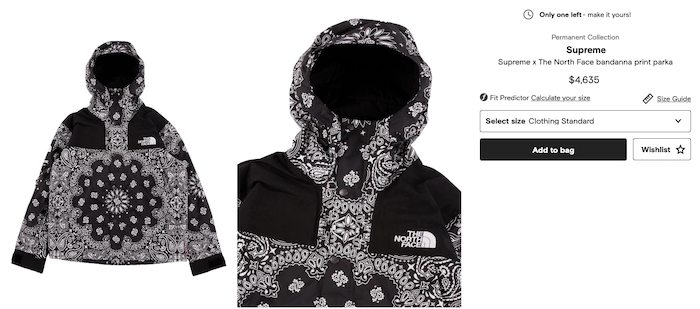
Luxury Marketing Trends
According to Statista, the global luxury goods market will increase from $285.1 billion in 2020 to $388 billion in 2025.
Despite what you might think, online sales of personal luxury goods are growing, too. McKinsey estimates 8% of all luxury sales are made online or around €20 billion. That’s a five-fold increase from 2009. What’s more, the majority (almost 80%) of purchases made in-store are influenced by digital.
The consultancy expects online luxury sales to triple by 2025 when almost one in five personal luxury sales will happen online.
Digital channels will be essential for luxury brands going forward. The pandemic hit department stores hard and forced luxury consumers to buy online more than before.
BCG predicts the e-commerce boom will continue in the future both for inspiration and for transactions.
Going digital will also be key to meeting today’s new luxury consumers and those of tomorrow. Millennials, who are entering their peak earning years, and Gen Z, many of whom are just entering the workforce, have grown up in the digital era and expect brands to have an online presence as high-quality as their products.
All that’s to say: digital marketing must be a key part of a luxury brand’s strategy going forward.
Luxury Brand Marketing Strategies
Here’s the thing, luxury marketing isn’t synonymous with digital marketing…yet.
Until now, luxury brands have been able to rely on full-page ads in premium magazines, billboards in duty-free stores, and high-end, high budget TV ads.
Not any more.
To survive in the increasingly competitive luxury space and attract new customers, luxury brands must understand what the luxury consumer wants from a brand and how digital can help them get there.
From SEO to PPC, apps to AR, there are loads of marketing strategies to explore.
Understand the Luxury Customer
The first step in developing a luxury marketing strategy is to understand your audience. Enter buyer personas.
A buyer persona is a detailed description of your ideal consumer. It will include their age, demographic, job, hobbies, salary, and anything else relevant. The more detail you can include, the better.
Here’s an example of a luxury consumer persona from Stella Rising.
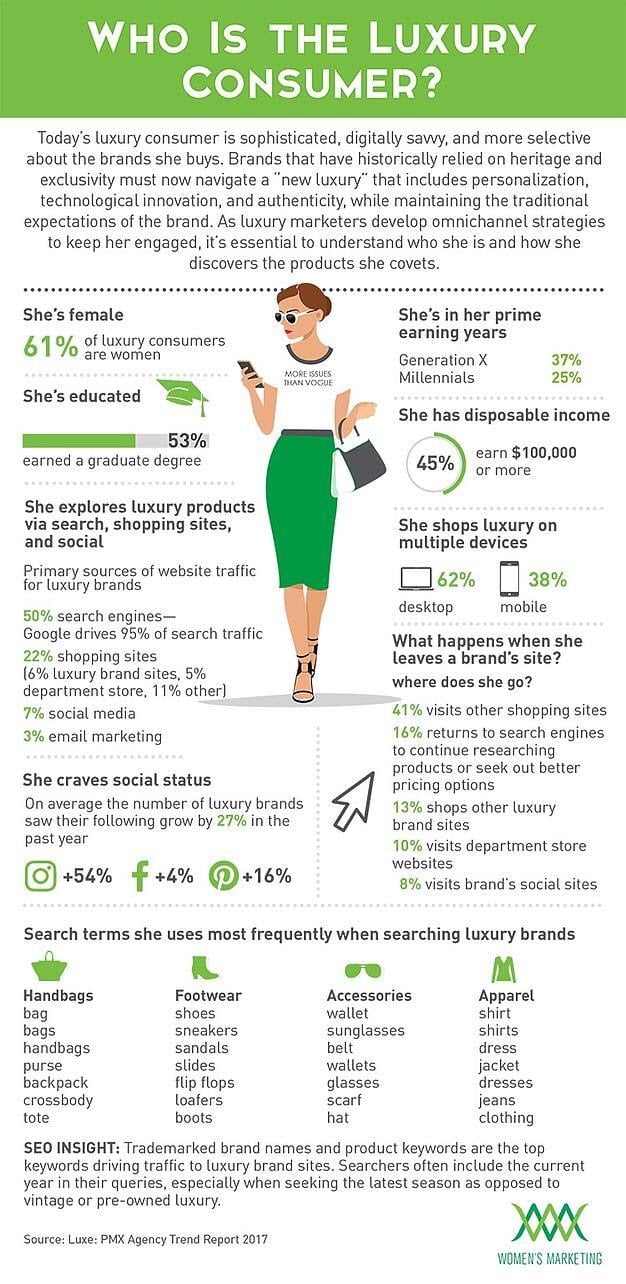
Keep in mind; you may not have just one buyer persona. If several different groups of people buy your products, you’ll need to develop a buyer persona for each of them.
Detailed buyer personas help your brand understand precisely who your customers are and what they want from your brand.
They will allow you to better communicate with your customers and focus your marketing efforts.
Develop Your Digital Luxury Marketing Strategy
Now you understand who your customers are and what they want from your brand, you can build a marketing strategy that will drive results.
Start by thinking about the channels you want to target. This could be a social media platform you want to pay particular attention to; it could be Google; it could even be a custom app.
Focus on one or two to start with, particularly if your luxury brand is new to digital marketing.
Next, define your goals. This may be increasing brand awareness, but a better and more measurable goal is an increase in sales. (It’s also easier to measure sales increase.)
Finally, work out how you’re going to measure your success. If you’re going to use SEO to increase revenue, for instance, find out how much revenue Google and Bing are responsible for right now. If you don’t already have Google Analytics tracking in place, now’s the time to set it up.
Experimental vs. Traditional Marketing
Most marketers are aware of traditional luxury marketing tactics. Full-page ads in premium magazines or weighty direct mail pieces are a luxury marketer’s bread and butter.
But those strategies won’t cut it in an increasingly digital world.
Many brands consider digital marketing experimental in itself. But I urge luxury brands to go beyond standard digital marketing tactics and explore more experimental channels.
One option is a brand app. Apps offer brands a way to speak to users directly through their smartphones. Your app could be as simple as a mobile responsive version of your website.
Or you could take things even further by integrating augmented reality features. Burberry, for instance, has launched an AR shopping tool that lets consumers see Burberry products in their surrounding environment.
Chanel has combined offline marketing with digital marketing in a holiday popup event at The Standard in New York. An AR app, which could be accessed on the Chanel website or via Snapchat, brought the popup to life.
Role of Loyalty in Luxury Marketing
Luxury brands have loyal consumers. This is important because the more loyal your customers, the less marketing you have to do.
Don’t worry; I’m not recommending creating a loyalty program. That could devalue your luxury brand.
Rather, you need to turn consumers into fiercely loyal brand advocates. One way to do that is through the quality of your products. Another way is through the quality of your marketing.
You can also partner with influencers on social media channels. Influencer marketing is incredibly cost-effective and, if done well, can put your brand in front of the right kind of consumers.
Just make sure to find influencers who already operate in the luxury space and whose audience buys the products they promote. Aspirational jet-setting influencers are a dime a dozen.
You want to work with the few who have the audience to back it up. Otherwise, you won’t see results.
Develop a Targeted Luxury Marketing Keyword Strategy
Whether you’re running an SEO campaign or a PPC campaign (or both), I recommend developing a highly targeted luxury marketing keyword strategy.
Start by targeting high-conversion keywords. Sure, attracting consumers in the research phase of their journey is important. But for the sake of your ROI, you’re going to want to target consumers who are ready to purchase.
The CPCs of luxury marketing terms can be expensive, given the competition and the price of products.
Try to advertise as the “top watch maker” on Google, and you’ll pay $80 per click. Ouch.

Or $50 to advertise as one of the best luxury compact cars.

If you want to see a return on your investment, focusing on high-intent keywords is essential.
You’ll also need to make careful use of your negative keyword list.
Unless you’re using negative keywords, you aren’t really in control over what terms your brand will appear. The last thing you want is for ads for your luxury brand to start showing up in searches containing “discount,” “sale,” or “free.”
The kind of consumer that clicks on those ads won’t match your buyer persona. Here’s how to add negative keywords to your ads.
Luxury Marketing Content Campaigns
A huge part of luxury marketing revolves around storytelling. Whether it’s the history of your brand or the craftsmanship of your products, you probably have a lot to say.
This makes content marketing campaigns a must for luxury brands.
What should you write about exactly? Well, apart from telling your brand story, I recommend using long-form content to help consumers find the right product for them.
Buying a luxury product is often a big decision, and consumers research their choices thoroughly before committing. Buying guides put your brand front and center for consideration while providing value and establishing a relationship even before the purchase has been made.
This is a strategy my team at NP Digital adopted for a prominent jewelry retailer that wanted to increase online sales.
We wrote a comprehensive piece of content about finding the perfect engagement ring that helped traffic from search engines to grow from 20% of all traffic to 30% of all traffic in the first six months of our partnership.
Your content can continue to add value for customers after purchase. Detailed guides on using and caring for luxury products make for excellent blog posts that can increase brand loyalty while attracting even more consumers.
Use the keywords you’ve discovered above to guide your content creation process. You’ll want to make sure there’s some form of content for every key term, whether that’s a category page, a blog post, or something else entirely.
SEO For Luxury Brands
Search engines are massive traffic drivers for luxury brands and play an important role in both the research and purchase phase of the consumer journey.
Yet, they are consistently undertilized by luxury brands. It doesn’t help that luxury brands tend to have poorly designed (but very good looking) websites and a lack of content for Google to crawl.
As I said above, creating new content is critical for luxury brands who want to succeed online. Targeting new, high-intent keywords is also important.
But you shouldn’t forget about the more technical aspects of SEO, like optimizing category pages. Or off-page factors, like building links.
The more time and effort you devote to understanding and implementing SEO, the more revenue your store should generate. For instance, we increase the revenue of our luxury jewelry client by 21% through SEO.
While Google should be your focus, don’t forget about Bing. Users of Microsoft’s search engine tend to be more affluent, with 25% of users having an income in the top 25%. It makes sense to focus some efforts on Bing SEO.
Conclusion
The luxury market is changing.
Luxury marketing can no longer be confined to TV channels, billboards, and glossy magazines. Now is the time to take your luxury brand digital and invest in SEO, PPC, and whatever social media your consumers use.
So here’s my question to you:
What will be the first digital channel you use to promote your luxury brand?
The post The Best Luxury Marketing Strategies appeared first on Neil Patel.
The Good and Bad of Deadstock Products for E-commerce
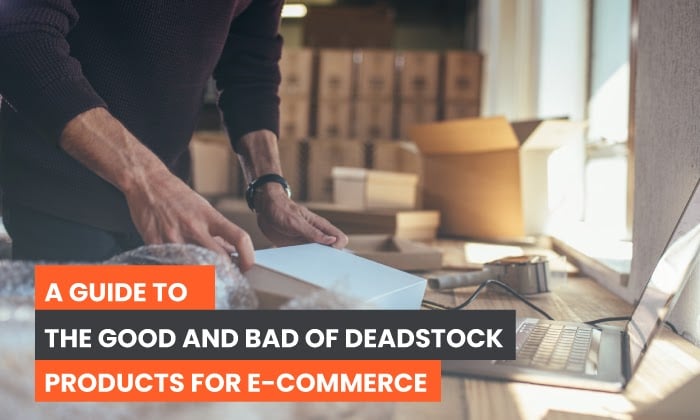
E-commerce retailers face many obstacles in the realm of online business.
A common yet persistent issue is deadstock products.
The accumulation of deadstock inventory can drive up operational and warehouse costs. As more products enter the warehouse, the cost of storing unsold items can drain the valuable financial resources of your business.
What’s more, seasonal trends and products make it difficult to eliminate deadstock products completely.
How to solve this problem? This article explains how to avoid deadstock and how to get rid of it when it piles up in your warehouse.
Let’s start with the definition for deadstock first.
What Does Deadstock Mean?
Deadstock is synonymous with dead inventory.
These are items that haven’t been sold and are very unlikely to sell. If you don’t use an inventory management system, these goods likely pile up and remain forgotten in your warehouse.
An alternative definition of “deadstock” refers to goods that are no longer sold in stores. In this case, these deadstock goods, like unused or unworn shoes or vintage apparel, are sold at much higher rates.
For the purposes of this article, we won’t explore the latter definition in this post.
Is Deadstock Bad for Business?
Deadstock comes with a price.
Retailers won’t be able to recoup the cost of manufacturing products if they never sell.
As a result, unwanted items take up space in your warehouse. A longer stay means more storage costs for your business.
How to calculate deadstock? To understand its consequences for your business, calculate the costs involved in holding onto these useless products.
List rental costs, utilities, equipment, insurance, and security used to guard your items.
Ideally, businesses make up for these costs through sales, but deadstock products remain stagnant in your warehouse. Instead of making a profit, retailers pay to keep these useless goods.
Deadstock also has an attached opportunity cost.
The space occupied by these items could have been used for “headstock” or highly profitable and bestselling items, which instantly make a profit for your business.
How to Avoid Deadstock
In my experience, you need to avoid deadstock as much as possible.
Business of Fashion reports that dead inventory costs around $50 billion per year for the US retail industry.
If a retail brand’s standard margin is around 60%, then a deadstock worth $40,000 represents around $100,000 worth of retail sales and $60,000 of gross margin dollars.
I’ve advised a lot of e-commerce stores, and I can tell you it’s best to avoid deadstock than to wait for it to snowball at a later time.
So today, I’ll share tips for avoiding deadstock.
1. Improve Inventory Management For Less Deadstock
Inventory management is a major cause of deadstock.
Fortunately, an inventory management system can guarantee your inventory is monitored and managed appropriately.
Here are some popular inventory management systems:
- inFlow Inventory: an inventory management system that can manage up to 100 products.
- Sortly Pro: a cloud-based inventory management system that can handle up to 100 transaction entries per month.
- Odoo: a free open source enterprise resource planning (ERP) solution.
- ZhenHub: a cloud-based inventory management system for small and medium-sized businesses (SMBs).
There is no right or wrong inventory management system. Instead, find a solution that meets your needs.
Once you have a system in place, keep track of the products on your shelves, as well as those that end up as dead inventory. In addition, you must identify the products with no sales or low sales for the past year.
An intelligent inventory management system can identify bestselling items, allowable return dates, expiration dates, as well as flopped goods you’re better off without.
2. Discount Potential Deadstock Items
Pay attention to what’s selling and what’s not.
Take into account the latest market trends. What are the popular products people love? How long will this trend last?
Seasonal products might be selling like hot cakes for the first few weeks, but the excitement fades eventually.
A good tip is to discount potential deadstock items by hosting end-of-season sales.
For example, Patagonia, The North Face, and H&M frequently have end-of-season sales to sell their jackets and coats once the winter season ends. This way, they can get rid of deadstock items and make way for next season’s collections.
Perishable goods won’t be sellable after their expiration date has passed. That’s precisely why you must monitor items that will almost reach their expiration date and then offer them at discounted prices.
Tools like Wasteless utilize AI to prevent food waste through a dynamic pricing model. By using machine learning, they can use variables like brand popularity, seasonal popularity, and expiration dates to determine the real-time price of perishable goods.
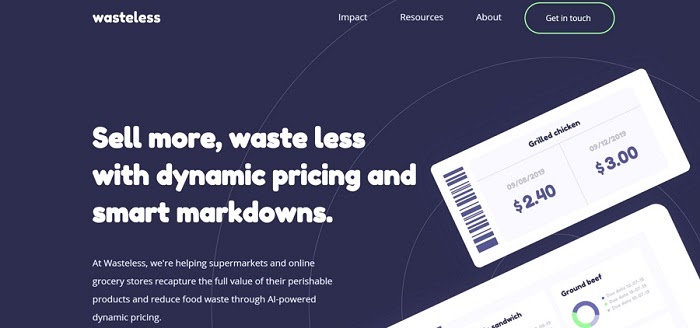
Of course, your profit margins will be lower than expected for discounted products. However, a discount helps you get rid of unpopular products, and it’s a lot better than stocking these goods in a warehouse and paying more for storage.
At the very least, you have an opportunity to make up for the manufacturing costs and break even.
3. Know Your Target Audience
This happens all the time: You promote the product, but it just won’t sell.
If an item remains unsold despite numerous promotions, your target audience probably doesn’t want them.
Every time you source potential products to sell, you must understand the conditions you are dealing with.
This is why market research and surveys are crucial to your success. The socioeconomic profile, gender, location, and interests of your audience can predict the outcome of the sales of your store.
So, before you pay for manufacturing costs, ensure your consumers want the product.
To get started, create a marketing persona for your online store. This doesn’t have to be complicated.
Here’s an example of a marketing persona that considers the demographics and characteristics of your consumers:
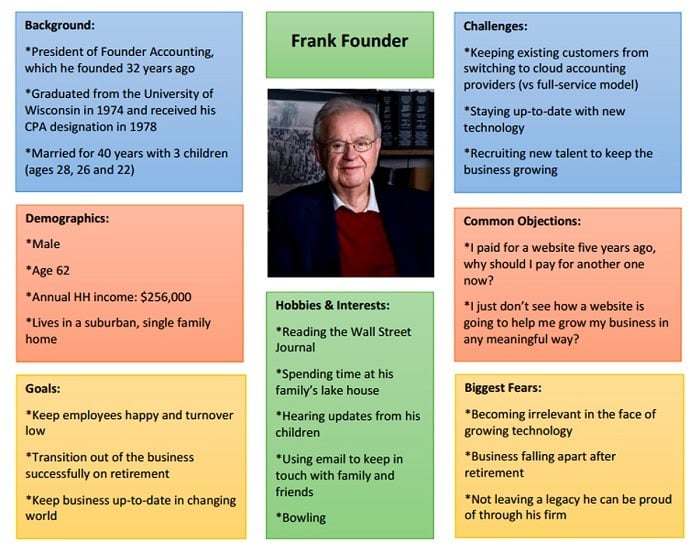
Another idea is to perform market research by sending regular surveys to pinpoint your customers’ needs. I highly recommend getting current customers as respondents because they’ve experienced your product and likely fit with the profile of your target market.
Survey Monkey recommends asking these questions to evaluate the product/market fit.
- How did you find this product?
- How would you feel if this product was no longer available?
- What are the benefits of using this product?
- What alternatives would you use if this product was no longer available?
- Have you recommended using this product to anyone?
It’s best to conduct surveys regularly to identify opportunities within your target market.
Also, understand the items and trends that customers love and take them into consideration for future product releases. You can use inventory management software to identify products that sold out quickly to make sure you’re selling the products that shoppers need.
Having more bestselling items is key to the elimination of deadstock, and while you won’t always be able to sell 100% of items in your inventory, knowing your customers and assessing product/market fit will help reduce the accumulation of deadstock.
4. Diversify Your Products to Avoid Deadstock
You may opt to sell bestselling items only to avoid deadstock completely.
However, you must guarantee that most of the bestselling items in your store don’t have the same features or characteristics. Otherwise, you can get more deadstock too.
Having too many similar items may mean cannibalization. Some customers may prefer one brand or item over another, which leads to low sales numbers for other goods.
This is common for retailers offering similar items from multiple brands.
Diversify your product inventory to avoid this consequence.
A good tip is to add complementary products of existing items in your e-commerce store. For starters, complementary goods are products that are used together. They may be completely different from an item you’re selling, but their combination of complementary goods will sweeten the deal.
For example, if you’re an iPhone retailer, then add iPhone cases and accessories to your arsenal. As the value of the latest iPhone decreases, it may become more mainstream. Thus, more people will be buying your cases and accessories in the future.
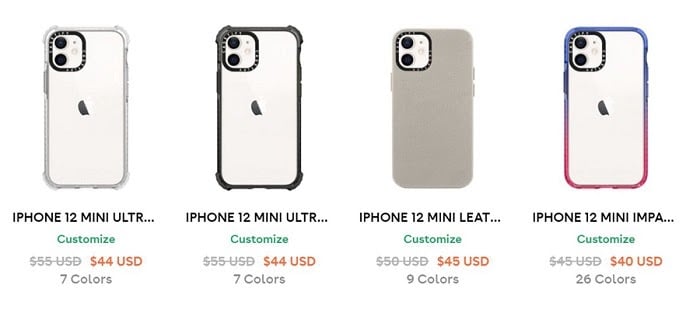
Alternatively, you can offer an assortment of related products, instead of selling them separately.
For instance, Harry’s – a men’s grooming brand – offers a “Truman Set,” which includes a foam shave gel, blades, and razors packed in one convenient package.
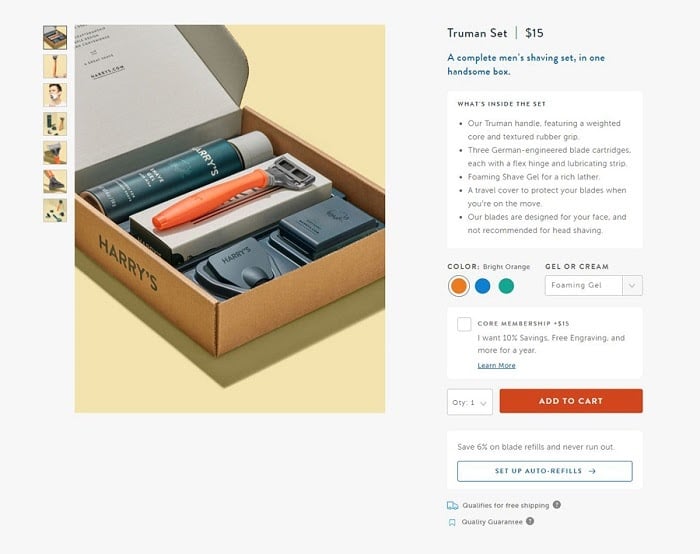
How Do I Get Rid Of Deadstock?
Now, if you already have deadstock, it’s time to get rid of it.
Here’s what you need to do.
1. Return Deadstock Items To Suppliers
If you’re in the window to return, this may be the best option.
In the short-run, you’ll pay a small fee, but at least you can avoid a major loss and more deadstock.
As long as the items are in good condition, you may be able to return them to the supplier. However, review the return policy of suppliers first to guarantee they allow this method.
Most suppliers have a restocking fee worth 10% of the merchandise. You’ll likely get an option to pay in credit rather than cash.
2. Put Deadstock in Clearance Sections and Bundles
What if you sold some items at a discount, but it just won’t sell? You can take it even further.
Find out the lowest price that you can sell these products. Then bundle related and complementary products together and sell them as a set.
For example, Glossier bundles related items together and offers them at a discounted price. Many beauty enthusiasts prefer a complete set sold at a discounted rate, rather than purchasing a single item with no discount.
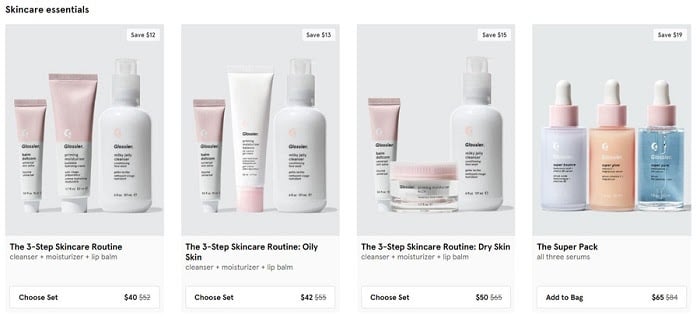
If you have a lot of stocks with the same item, get rid of them through freebies and giveaways. Consumers love to get free stuff, so it may compel them to return to your online store and make a purchase.
During the holidays, you can bundle items to create holiday gift sets with an assortment of products.
For example, Soko Glam bundles miniature-sized skincare products and sells them as a gift set for the season of giving. Plus, customers who make orders above $135 will receive a Dreamy Satin Pillowcase while supplies last.
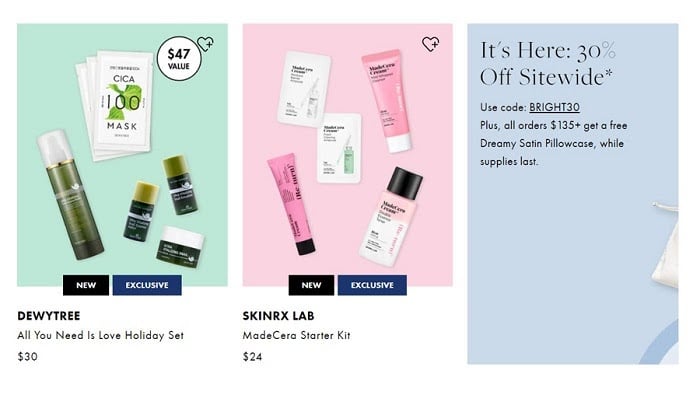
3. Sell to Deadstock Buyers
You’ll likely lose some cash, but getting some money back is better than a total loss.
Here are some deadstock buyers to consider:
- Wholesale: If you have a lot of deadstock in good condition, you can sell them to wholesalers. For clothing retailers, popular boutique wholesale clothing suppliers include Sugarlips Wholesale, Bloom Wholesale, Wholesale Fashion Square, Tasha Apparel, Magnolia Fashion Wholesale, and LAShowRoom.
- Amazon Seller Central: Amazon has a Seller Central where you can adjust the pricing or match your competitor’s lowest price.
- eBay: Deadstock consisting of repaired or returned products could be sold to eBay at drastically reduced costs.
- Consignment shops and warehouses: These buyers usually purchase clothing, home goods, and old items that could be sold at low prices.
- Closeout liquidators: These businesses can buy a bulk of your deadstock and resell it in their own stores at cheaper prices.
4. Donate Deadstock to Charities
Finally, if a product just won’t sell, consider donating it to charity.
Donating to charity is a popular option for clothing retailers. You can sell deadstock items to discount stores like T.J.Maxx or the Outnet as a last-ditch attempt to make sales.
Some foundations like The Salvation Army and Oxfam accept donated clothes.
We bet there are many charities in your local communities and cities. You can donate to any organization, just make sure it’s legal. Find a reputable charity where you can sell your items.
While you may not be able to sell these goods, you can claim a tax write off for donating them. If handled well, this initiative will make your business look good.
Conclusion
If you want to eliminate deadstock products, make an active effort to find products that will sell.
Use an inventory management system to track unwanted items in your inventory. Bundle deadstock products and sell them as gift bundles or give them away as freebies. As a last resort, you can even sell deadstock products to wholesalers, consignment shops, Amazon, or eBay.
There are many options to avoid the accumulation of deadstock and get rid of unsold items stuck in your inventory,
How will you avoid deadstock products?
The post The Good and Bad of Deadstock Products for E-commerce appeared first on Neil Patel.
How Using Emotional Marketing in Content Can Help Drive Way More Sales

Whether you care to admit it or not, the decisions you make today will be driven by your emotions. In emotional marketing, we talk a lot about using psychological triggers to get customers to click, convert, engage, etc.
“By leveraging common psychological triggers all people have,” you might hear, “you can drive more sales.”
While it may feel like we make decisions with our minds, using logic and reasoning, the “mental triggers” we hear about are tied more to emotion than anything else.
Case in point, Antonio Damasio spent time studying individuals with damage to the area of the brain where emotions were generated and processed.
While these subjects functioned just like anyone else, they couldn’t feel emotion.
The other thing they had in common was they all had trouble with making decisions.
Even simple decisions about what to eat proved difficult.
While they could describe what they should be doing using logic and reason, most decisions couldn’t be settled with simple rationale.
Without emotion, they weren’t able to make a choice.
This is supported by data from Gerard Zaltman, author of “How Customers Think: Essential Insights into the Mind of the Market.”
Zaltman found that 95% of cognition happens beyond our conscious brain, instead coming from our subconscious, emotional brain.

Emotions are an X factor you can’t control, but you can’t afford to ignore them in your content marketing.
Why is Emotion Marketing so Effective?
When you make an emotional connection with your audience, it’s incredibly easy to steer them to the desired outcome.
You’ve formed an emotional bond, however brief and fleeting, that makes them open to ideas and suggestions. It creates a certain level of trust that’s virtually impossible to artificially manifest.
Rob Walker and Joshua Glen found firsthand what an emotional connection can do.
In one experiment, they bought hundreds of items from thrift stores and similar locations — all cheaply priced.
The duo wanted to see if they could sell the products using an emotional connection through the power of stories alone.
With 200 writers on board, they generated fictional stories for the products and used those stories to sell the thrift store items at auction on eBay.
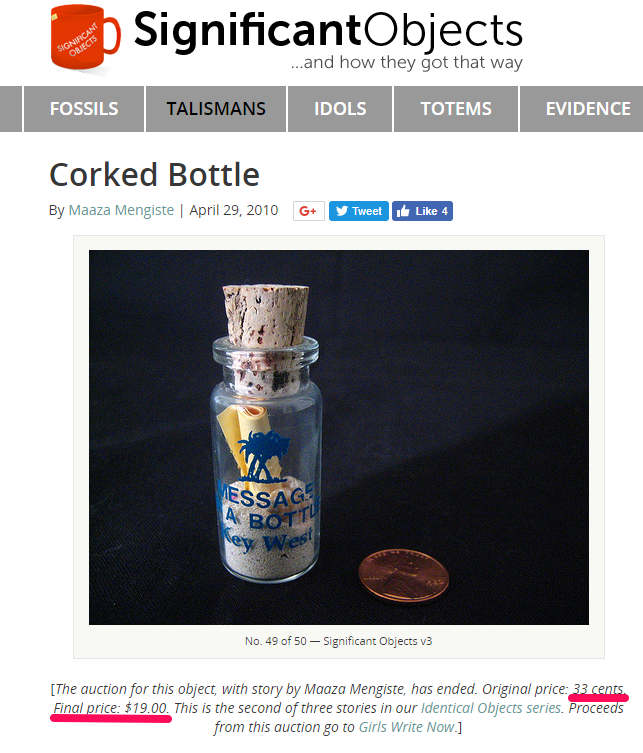
They raised just under $8,000, which was a profit of approximately 2,700%.
And they did it all using that emotional connection through storytelling.
That’s not to say there isn’t a place for the logical or the rational in decision making.
This is where marketers often leverage the theory of dual processing in psychological marketing.
The theory holds that the brain processes thoughts and decisions on two levels.
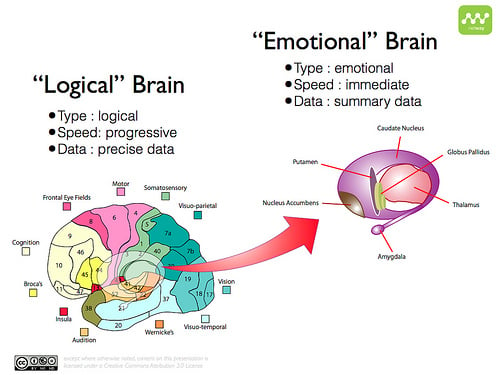
The first level is that of emotion, which processes automatically, unconsciously, and provides a rapid response when we need it with virtually no effort.
The second level is the more deliberate and conscious thought process, where we handle decisions with reason and logic. It happens far slower than the emotional response.
In most cases, we fire back with a ready response from our emotions and then try to consciously rationalize it.
Think about some big-brand rivalries and preferences will surface in your mind.
How do you feel when you look at this major brand comparison?
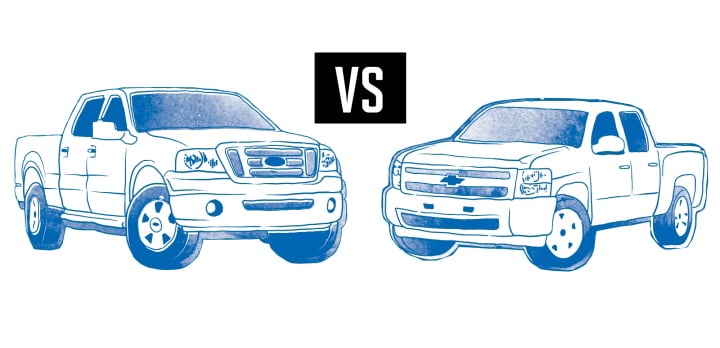
Here’s another common one that has people divided, sometimes within the same family:
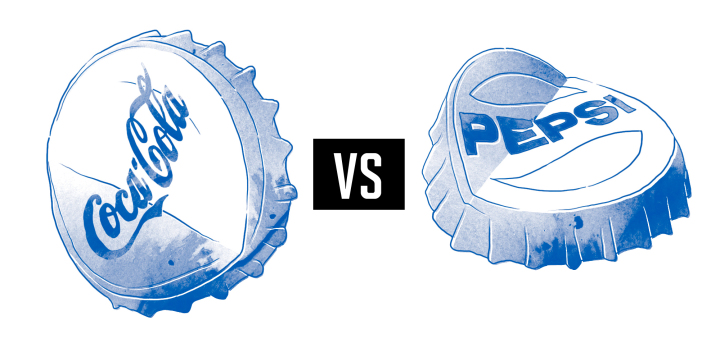
And then there’s this brand rivalry we know all too well.

In each of these, you likely have an opinion almost instantly about which you prefer, but it’s not because you have a logical reason.
It’s typically tied to emotion and/or experience; how you feel using their products, or how the brands left you feeling after an experience or reading a news article.
The brain then tries to rationalize that emotional response.
For example, your emotional response goes straight to Coke and then your brain works to rationalize the decision by deciding that it tastes better in a can, it’s fizzier, has a stronger bite than Pepsi, etc.
So, while you might feel like you’re making a rational choice about your beverage, it’s really just an emotional one.
The most successful marketers know how to lean on the emotional over logic in order to make their content draw in the audience.
That’s why nearly a third of marketers report significant profit gains when running emotional campaigns, but the number of successful campaigns dips if you introduce logic into the marketing.
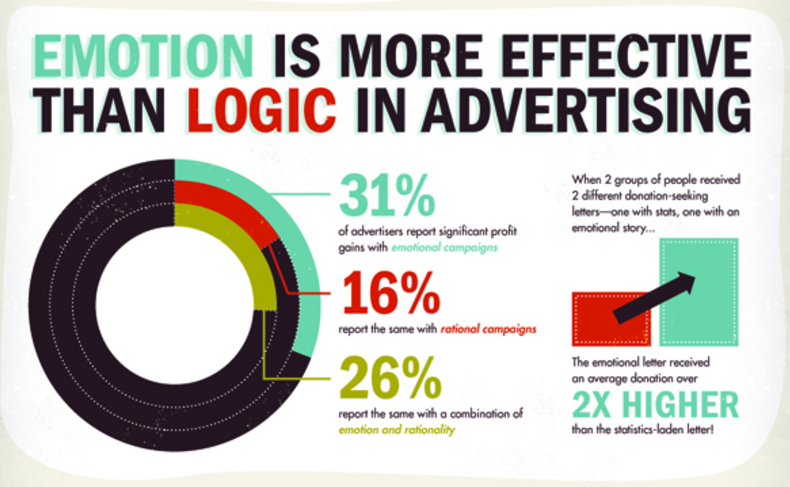
And those results get sliced in half when marketers switch to logic over emotion.
Emotion Marketing Doesn’t Guarantee Successful Engagement
We experience a laundry list of emotions every day.
Is it really as simple as leveraging some emotion to make content more effective?
Yes and no.
Emotion is certainly important, but there are also other factors like timing, exposure, the format of the content, how it’s presented, who produced or shared it, etc.
Despite understanding the role emotion plays in content, we still haven’t quite perfected a formula for what makes content go viral.
Though we’ve gotten pretty close.
Brands have long tried to inflate the consumer’s emotional response through manufactured content; some met with great success.
Take, for example, Intel’s five-part “Meet the Makers” series.
The videos profile a person around the world who uses Intel’s technology to create new experiences and build new technology that makes a difference in the world.

Like 13-year-old Shubham Banerrjee, who used Intel’s technology to build an affordable Braille printer.

And of course, some companies try to leverage emotion and create viral campaigns that just don’t take off.
CIO reported a number of failed viral marketing campaigns, such as “Walmarting Across America.”
In this blog, two average Americans travel across the country visiting Walmart locations, reporting their interactions on a blog along the way.
After countless upbeat entries about how people loved working for the company, it was discovered that the trip was paid for by Walmart and the entire thing was a campaign created and managed by the company’s PR firm.
That didn’t receive a warm reception from the blogosphere, which deemed the content to be a “flog” or fake blog.
Which Emotions Attract the Most Marketing Engagement in Content?
Many emotions fuel our behaviors and our decisions, especially our purchase decisions.
Some more than others — especially when they’re authentic.
A study was done by Buzzsumo analyzing the top 10,000 most-shared articles on the web. Those articles were then mapped to emotions to see which emotions had the greatest influence on content.
The most popular:
- Awe (25%)
- Laughter (17%)
- Amusement (15%)
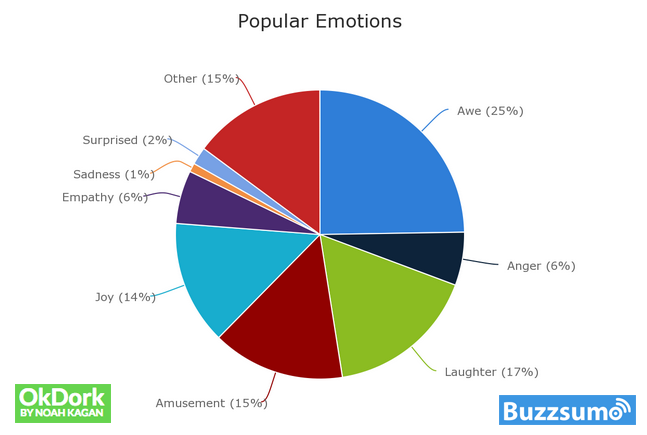
Conversely, the least popular were sadness and anger, totaling just 7% of the content that was most shared.
Two researchers at Wharton also wanted to dig deeper into virally shared content to find commonalities and better understand what makes that content spread.
What they found was the emotional element, and some very specific results tied to emotions.
- Content is far more likely to be shared when it makes people feel good or it creates positive feelings such as leaving them entertained.
- Facts or data that shock people or leave them in awe were more likely to be shared.
- Instilling fear or anxiety pushes engagement higher, from comments being posted to content being shared.
- People most commonly shared content that incited anger, leaving comments as well.
While some emotions are more likely to engage than others, every audience is different. What drives one to action may do very little for another.
This modern adaptation of Robert Plutchik’s Wheel of Emotion, illustrated by CopyPress, shows the range under eight primary emotions: joy, trust, fear, surprise, sadness, disgust, anger, and anticipation.

For content to be widely shared and have an impact on your audience, it needs to leverage one or more of these emotions.
The proof is on the web, not only in the statistics I shared above, but also in the popularity of user communities that regularly share content.
Just look at Reddit and some of the most popular subreddits by subscriber count. Each can be tied back to emotions (some more obviously than others) like anticipation, awe, joy, and more.

Here’s how some of those emotions can play into the engagement with your audience:
Anxiety May Cause Uncertainty For Customers
You don’t want your audience to make bad decisions. Bad decisions can lead to buyer’s remorse, which can paint your brand and the overall experience in a negative light.
But it can be helpful if you leave the audience a bit more open to influence.
A Berkeley study revealed that anxiety can be linked to difficulty in using information around us to make decisions. When we experience uncertainty, it becomes harder to make decisions and our judgment is clouded.
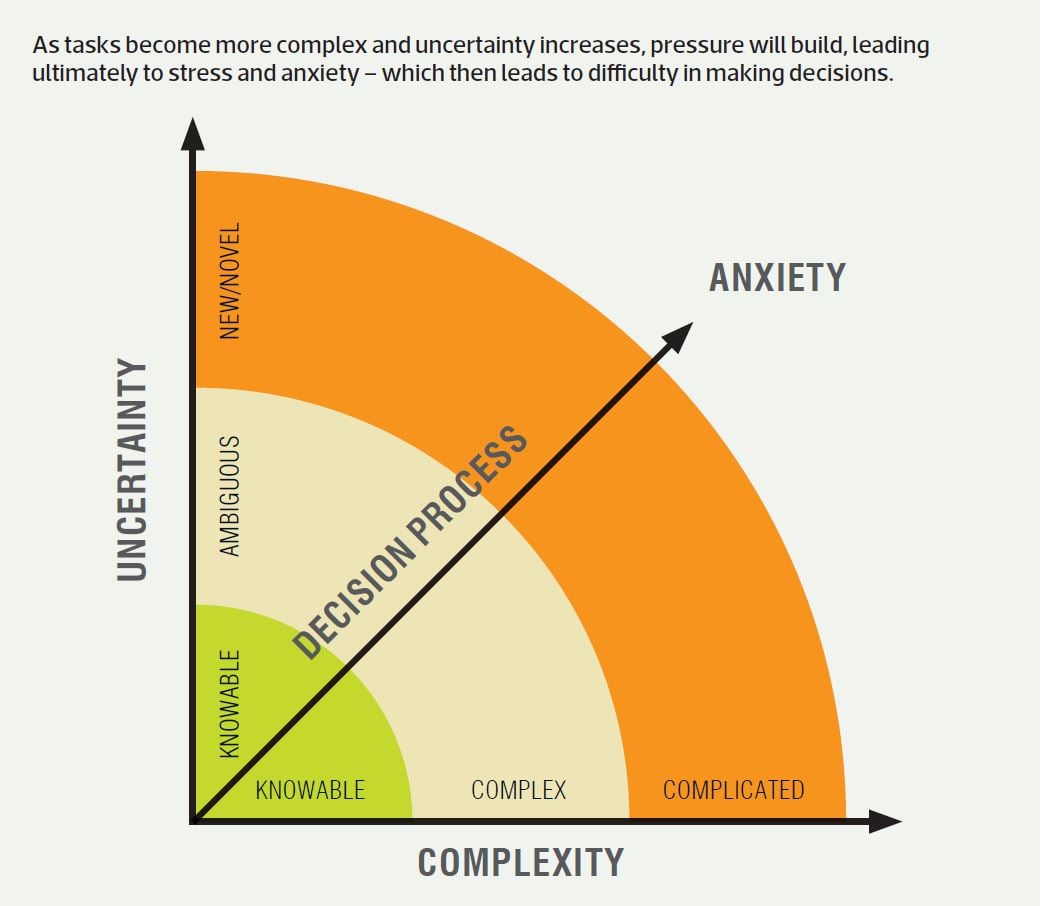
Still, anxiety can also spur people to act as a result of that uncertainty.
Take a two-year study by Wharton Ph.D. student Alison Wood Brooks and a Harvard Business School professor.
They found that upon increasing the anxiety of certain subjects with video footage, 90% of the “anxious” participants opted to seek advice and were more likely to take it.
Only 72% of the participants in a neutral state, who viewed a different video, sought advice.
Capture the Focus of Your Emotional Marketing Audience With Awe
Awe is comparable to wonder, but it doesn’t always fall under the umbrella of joy or humor.
It’s intended to captivate the audience and keep them riveted.
You often see this kind of hook in headlines that seem so earth-shatteringly significant that no one in their right mind would want to miss it.
Here’s a good example of that kind of awe used in content when Dropbox first launched.

Co-founder Drew Houston submitted his product to the website Digg, hoping to get some visibility from the social bookmarking site. That headline helped significantly.
Another great example of using Awe to capture attention is a video produced by Texas Armoring Corporation.
To emphasize the quality of the company’s bullet-resistant glass, the CEO crouched behind one of TAC’s glass panels while several rounds were fired at it from an AK-47.
Awe can impact decision making as much as anxiety.
A study from Stanford University found that people experiencing awe are more focused on the present and less distracted by other things in life. They also tend to be more giving of their time.
When you have their attention and their focus, they’re more likely to have time to rationalize a decision.
Drive People to Action With Laughter and Joy Through Emotional Marketing
While joy and laughter can have their lines blurred, they’re really two different emotions when it comes to your content.
Because while laughter often leads to joy, not everything that is joyful is laugh-out-loud funny.
Still, next to awe, joy, laughter, and amusement were the highest contributors to social sharing and engagement in the above studies.
That influence goes all the way back to early childhood.
As babies, out first emotional action not long after being born is to respond to the smile of our parents with our own smile.

Per psychoanalyst Donald Winnicott, joy and amusement are hardwired into us from birth.
His studies tell us that our innate desire for joy increases when it’s shared. That’s the nature of the “social smile.”
That explains why these feelings or emotions are such huge drivers behind the virality of content. Happiness, overall, is a huge driver for content sharing.
In fact, Jonah Berger’s study of the most-shared articles in the New York Times (around 7,000 articles) revealed the same kind of results around emotion.
The more positive the article, the more likely it was to go viral.
Brands have worked “joy marketing” into their strategies for decades, aiming to make their audience feel warm, comfortable, and happy.
That’s the intent of campaigns like P&G’s highly successful and viral “Thank You, Mom” campaigns that are injected with a lot of emotion (especially joy) when celebrating the strength of mothers.

Joy can take a lot of forms, though, and it doesn’t have to be commercially intended to elicit a direct sale.
Look at what Beringer Vineyards did with influencer marketing.
Russian Instagram sensations Murad and Nataly Osmann built a following of more than 4.5 million people with photos featuring them holding hands at locations around the globe during their world travels.
They attached the hashtag #FollowMeTo on those posts.

The couple teamed up with Beringer Vineyards to create some images meant to inspire joy, love, and of course the sense of adventure the couple already shared with their hashtag.

Immediate Gains in Emotional Marketing From Anger
Anger may be perceived as a negative emotion by some, but it can have positive influences as well as positive outcomes when leveraged in the right way.
A leading researcher in the study of anger, Dr. Carol Tavris, draws a parallel between anger and how it impacted society over the years.
Women’s suffrage, for example, developed from anger and frustration.
Anger can be empowering for the individual, bringing a sense of clarity and positive-forward momentum. It gives people a feeling of direction and control according to a study from Carnegie Mellon.
In the previously mentioned study on content shares in the New York Times, negatively perceived emotions like anger are equally associated with the virality of content.
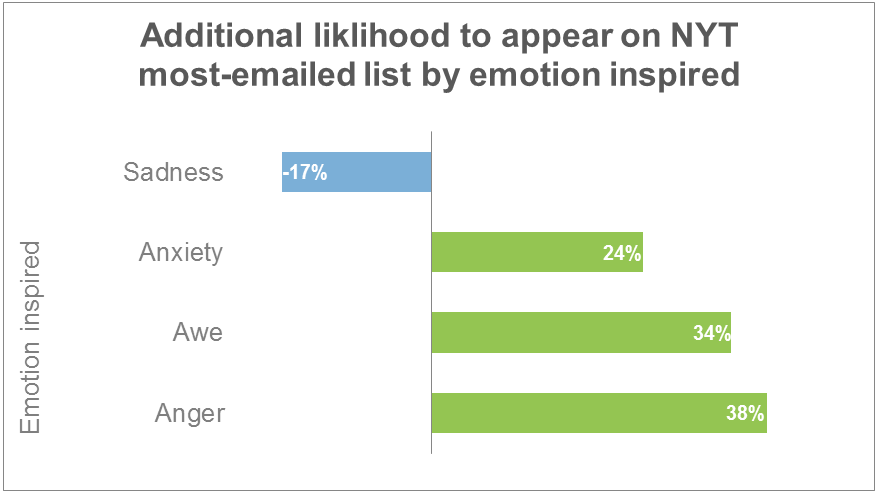
In fact, Berger’s study of the New York Times content found that content which incites feelings of frustration or anger is 34% more likely to be featured on the Time’s most emailed list than the average article.
Now, I’m not suggesting that you deliberately create controversy by taking shots at readers or picking fights.
The key with using anger in content is to frame an issue that incites anger or frustration in a way that’s constructive.
You have to be thought-provoking and engaging.
This interactive graph from the New York Times is an example of how content can lead to frustration and anger over economic or societal issues.

This piece of content is simple, yet it provokes engagement as well as thought when results are revealed in comparison to what an individual perceives to be the truth.
Using the Right Emotional Marketing Words in Content
The difference between logic and emotion in content comes down to the words we use and how we position statements and information.
It’s just like the laundry list of power words used to improve conversion, or terms commonly used in e-commerce to get customers to buy more products.
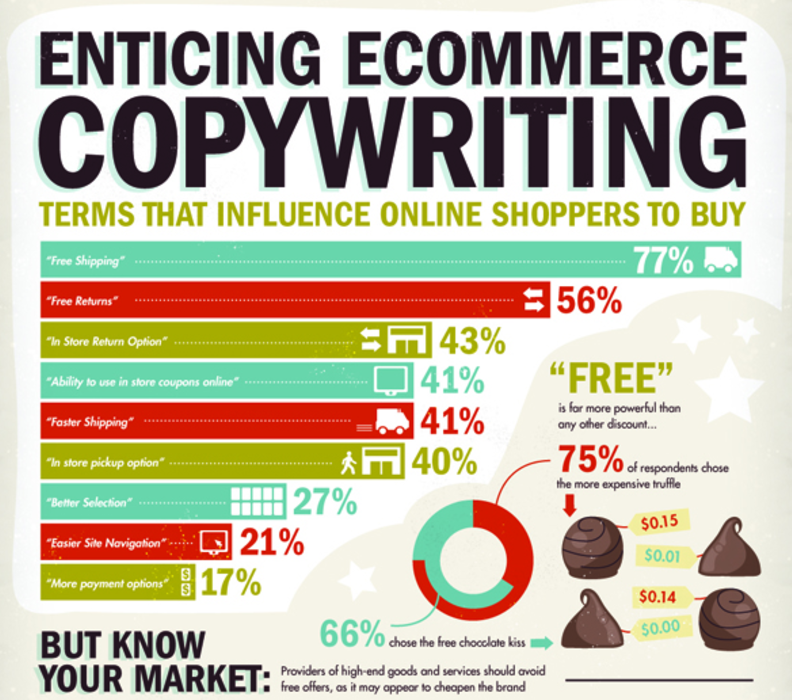
When creating copy and content, you have to be acutely aware of whether you’re taking a rational or emotional approach to the information you’re sharing.
You need to think about the response you want to elicit to help guide your content development to make the right kind of psychological and emotional connection with your audience.
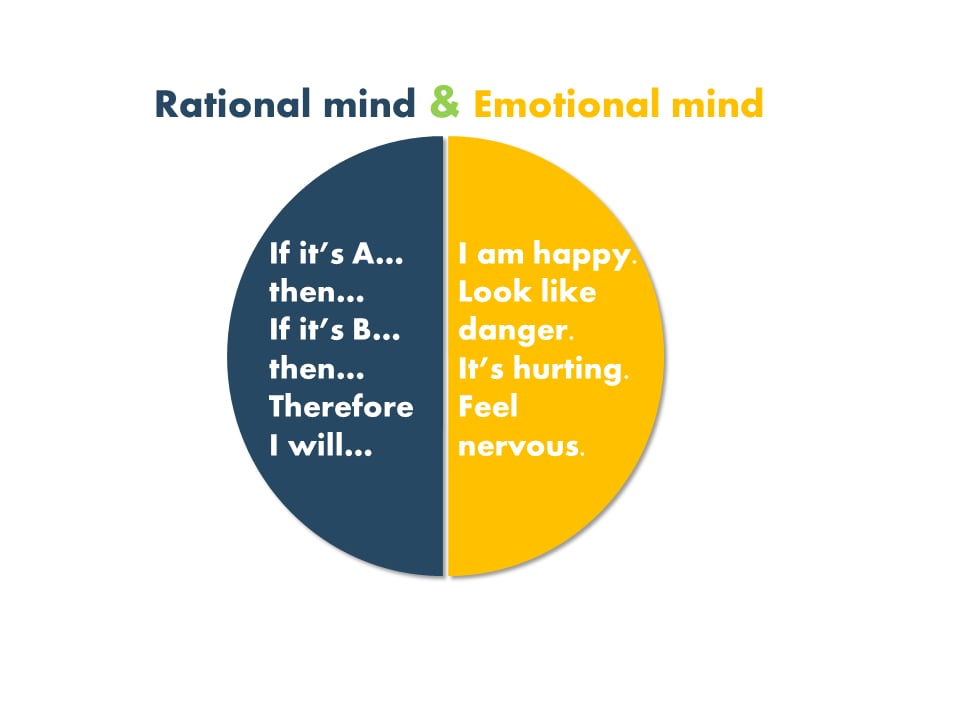
The context of your copy can remain the same.
By changing the words you use, however, you can make content appeal more to the emotions of the audience and prospective customer.
The simplest approach to finding the right high-emotion words takes only three steps:
- Think about the action you want your audience to take when they read your content.
- Decide what kind of emotional state will drive that action. What would make them do what you want them to do?
- Choose emotionally persuasive words appropriate to the action and the emotion.
What you’ll find in researching the right words is that emotionally persuasive and impactful words tend to be abrupt. It’s the short, concise, basic words that appeal most to our emotions over our intellect.
Just look at this list from the Persuasion Revolution.
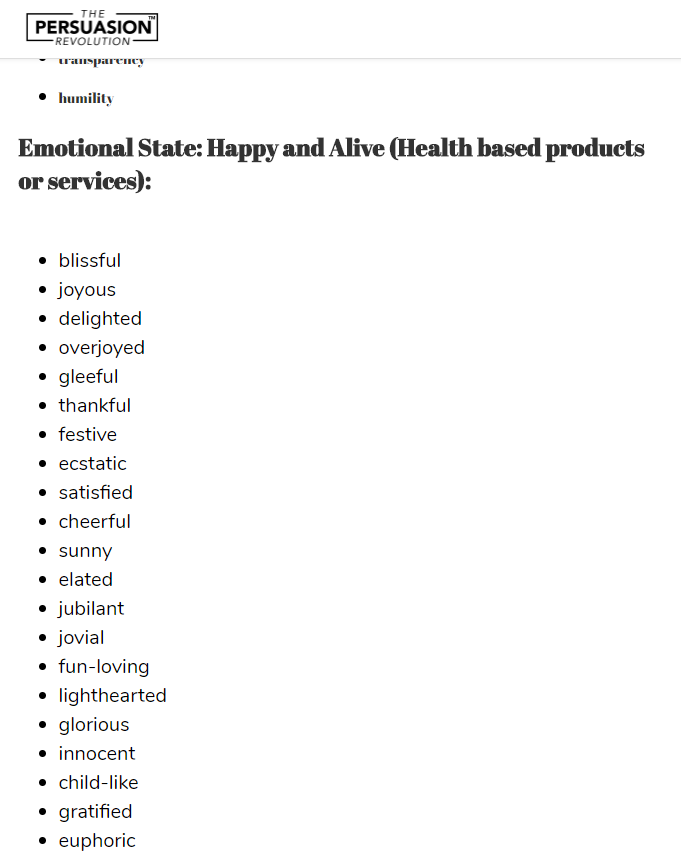
The majority of this emotionally weighted list (and there are over 350 items) is made up of shorter words.
The rational mind, on the other hand, tends to associate with longer and more complex words.
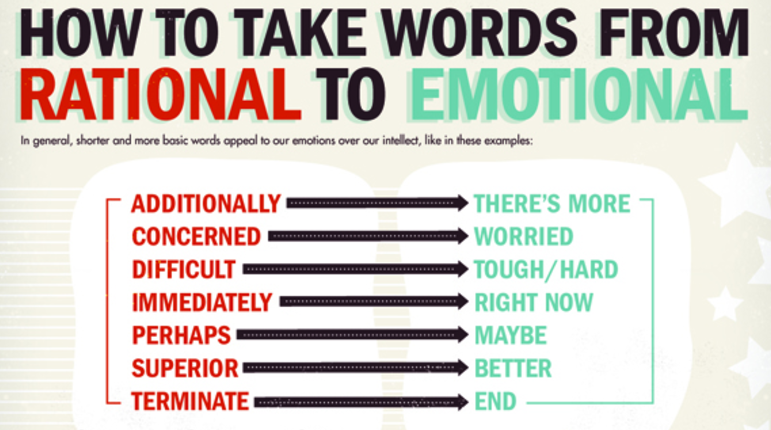
You Can’t Assume When it Comes to Emotional Marketing
It’s not easy to make that emotional connection with your audience. You have to know them.
Like anything else in marketing, your decisions and the content you create needs to be based on data. In this case, that data is your audience research.
That same research that tells you what topics to create, where your audience spends their time, and the content they prefer to view, can clue you into how to make that emotional connection.
You just need to expand your buyer personas.

In this case, you want to build up the psychological profile of your audience. You can achieve this by asking the right questions to help steer your content research and production.
- What do they find humorous?
- What are the pain points that frustrate them?
- What topics make them angry?
- What are common problems they speak about?
- What kind of content is being shared that clearly pleases them or brings joy?
Your research could turn up a common topic or theme that appears frequently in the content they read and share.
For example, you might discover that a certain segment or demographic in your audience has a strong affinity to family values, or health and wellness.
Turn that into a content campaign that shares the feel-good side of your company.
Delve into the family life of your employees, how your company supports the work/life balance, or better health initiatives.
Google is well known for its company structure, promoting flexible schedules, support of family time, personal projects, and a focus on work/life balance.
The company often shares behind-the-scenes images (visual content) showing off employees enjoying what they do. Here’s an example from Google Sydney’s offices:

That can influence a positive emotional response toward the brand when targeted segments see that content.
Emotional Marketing Works in the B2B Process
Don’t get caught up with the dated idea that emotion is only applicable to consumer-focused businesses.
Emotional marketing has its place in the B2B world as well.
You may be dealing with a longer buying process between one or more organizations, but the decisions are still made (and fueled by) people who are absolutely driven by emotion.
That includes emotions like:
- Awe: over what a solution is capable of and feeling empowered to bring that solution to the workplace.
- Anticipation: in finding a piece of the puzzle in a product or service that will help the company achieve its next goal or milestone.
- Fear: in purchase decisions that could reflect on the individual, resulting in a personal risk associated with a B2B purchase.
- Joy: in knowing that a B2B purchase is likely to lead to a positive outcome that will reflect positively on the individual.
Emotion absolutely influences B2B purchases, and in some cases, emotion matters even more than logic and reason.
Conclusion
You hold a great deal of influence with your audience when you’re able to tap into their emotions.
Once you understand your audience, you can better determine their emotional state.
From there, make the decision about whether you need to influence and exploit emotions that are already present, or if you want to create or give rise to emotions the audience wasn’t initially expecting or experiencing.
Even the most (seemingly) rational decisions are influenced by emotion — and that applies to everyone.
When you learn how to leverage that emotion in your content, you will see increases in engagement, social action, and conversions within your funnel.
How do you use emotion in your content and copy?
The post How Using Emotional Marketing in Content Can Help Drive Way More Sales appeared first on Neil Patel.
source https://neilpatel.com/blog/emotions-for-content-marketing/
How to Create Hyperlocal Ad Campaigns
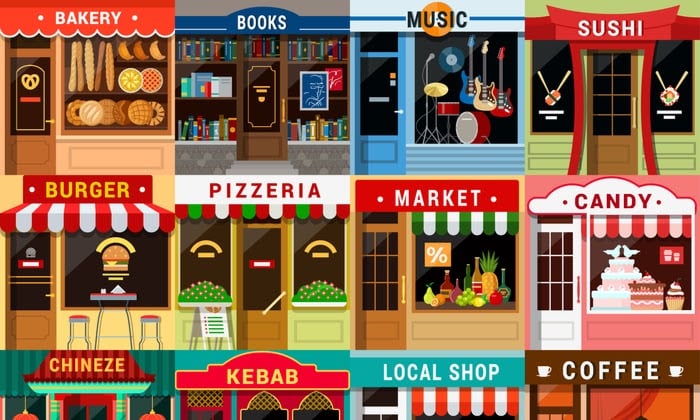
In these modern times of digital transformation, it may seem like most digital marketing strategies are designed for online businesses.
So are there any digital marketing strategies for brick-and-mortar businesses?
Yes, there are, and one of the most effective ones is hyperlocal marketing.
What is Hyperlocal Marketing?
As the name suggests, hyperlocal marketing is a marketing strategy that focuses on reaching customers in your vicinity. It is targeted to motivated people who are ready to buy your products.
The main goal of hyperlocal marketing is to increase foot traffic to your business. This is achieved by strategically placing the right ads in front of the right people at the right time.
It could also serve the purpose of raising brand awareness in your specific locale.
Several factors are considered, with the main one being your prospect’s location.
Hence the name hyperlocal marketing.
Advantages of Hyperlocal Marketing
Many businesses are adopting hyperlocal marketing for the tremendous results it brings. It has many advantages over other marketing methods for both online and offline businesses. Here are the top five:
Bring in Hot Hyperlocal Leads
Because it is a very niche marketing technique, hyperlocal marketing has the advantage of bringing in leads that are ready to make a purchase. That’s because most of the people targeted by hyperlocal ad campaigns are already looking for the product or service you offer.
Take, for example, someone looking for a coffee shop. They’ll search for a coffee shop “near me,” and if they are in your vicinity, your coffee shop will be recommended to them by search engines. Or, they’ll be served one of your ads on their social media timelines.
Even if they’re not actively looking for a coffee shop, you can send out push notifications alerting people in your vicinity of a special you’re running.
Don’t Require Huge Ad Spend
Because you don’t have to run regional or nationwide campaigns, your ad spend can be kept at a bare minimum.
You also save on your advertising budget because you’re targeting a hyper-specific audience. This has the effect of reducing your cost per target while increasing your return on ad spend (ROAS).
Easy to Set Up and Run
Again, the niche nature of hyperlocal ad campaigns makes it easy to set up and run. It’s also easier to create personalized ads, resulting in higher conversion rates.
Easy to Measure Performance
When it comes to measuring performance, it’s easy to track as you can tell where your foot traffic is coming from.
Help Build Relationships with Customers
One of the biggest keys to growing a business is to build relationships with your customers.
Executed well, hyperlocal marketing will help people in your geographic area know that they can depend on you when they need a product or service you offer. As a result, most will turn into repeat customers. Better yet, they can end up being your brand ambassadors.
Hyperlocal Ads Work in Real-Time
A big advantage of hyperlocal marketing is that it works in real-time. This ability increases conversion rates as it offers prospects deals on products or services they’re actively looking for.
With all these advantages, you can’t afford to ignore hyperlocal marketing.
How Does Hyperlocal Advertising Work?
Thanks to technology, marketers can pinpoint the exact locations of their prospects. This can be done through:
- IP addresses
- GPS
- Wi-Fi
- Bluetooth signals
Knowing a prospect’s location is crucial to running hyperlocal ad campaigns as it allows you to narrow down your audience to a specific area. Most ad platforms, like Google and Facebook, give you the option of targeting a particular locality, making it easy for you to create your hyperlocal ad campaigns.
Once you’ve determined your target area, you can then set triggers that will deploy your ads.
Examples of triggers can include:
- Search queries
- Search history
- Behavioral activity (places your prospects have recently visited)
Depending on your campaign, your hyperlocal ads could be in the form of text messages, app notifications, email alerts, ads on search engine results pages (SERPs), and more. It could even be a combination. These are sent to the prospects’ mobile device when they enter your selected boundary and perform an action that sets off your triggers.
Fundamentals to Get Right Before Launching Hyperlocal Ad Campaigns
Now you know what hyperlocal marketing is, and you also see why it’s so essential to your marketing strategy.
Let’s look at some fundamentals you must get right before creating your hyperlocal ad campaigns that drive results.
Optimize Your Google My Business Page
One of your first stops as you lay the foundation for your hyperlocal ad campaigns is your Google My Business (GMB) listing.
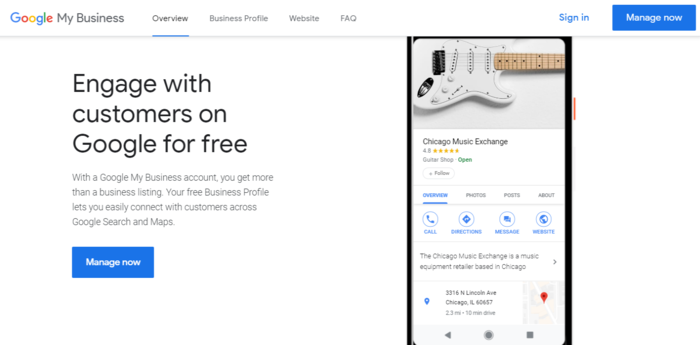
GMB is a free tool from Google that enables businesses to manage their online presence on Google search results. It’s especially useful for brick-and-mortar businesses as it helps Google users find businesses near them.
You must optimize your GMB listing as Google uses three main criteria when serving users with GMB listings:
- Relevance. For your business to be deemed relevant, it must match a searcher’s query.
- Prominence. This has to do with whether or not your business is reliable enough to recommend to users.
- Proximity. Is your business close enough to the user to recommend?
If you can optimize for these three, you’ll stand a better chance of success with your hyperlocal ad campaigns.
So how do you optimize your GMB listing?
Optimizing for GMB Relevance
- Create detailed keyword-focused business descriptions
- Choose the right category that describes your business
- Set your workdays and operating hours
Optimizing for GMB Prominence
- Get high-quality reviews
- Use high-quality images
- Manage your online reputation well
Optimizing for GMB Proximity
While it’s virtually impossible to influence a searcher’s proximity to your business, there are a few best practices you can follow to improve your chances of Google serving your GMB listing in search results.
One such best practice is to create separate landing pages for each of your locations if you have more than one business location.
Another tip is to leverage famous landmarks near you. Including these in your business description will help your business show up when users search using that landmark as a reference. Here’s an arbitrary example:
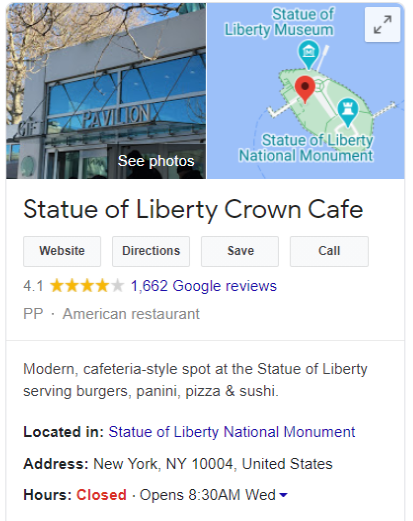
With your GMB listing optimized, we can now move on to other fundamental elements you need to get right if your hyperlocal ad campaigns are to give you a healthy ROAS.
Ensure Your Local Search and Mobile Optimization is On Point
Local SEO plays a huge role in the effectiveness of your hyperlocal ad campaigns.
Research by Google shows that “near me” searches on mobile have increased by over 500% over the last few years.
A few tips to help you with this include:
- Create hyperlocal content (using location-specific keywords)
- Feature your location in some of your URLs
- Create location-specific metadata
- Focus on long-tail keywords
- Optimize for voice search
- Include contact info on your website
Besides optimizing for local SEO you must make sure your website is mobile-friendly.
Most local searches are performed on mobile devices, and if your website doesn’t display correctly on mobile devices, you stand a chance of losing your prospects. With hyperlocal marketing, a positive online user experience (UX) can help drive your offline conversions.
If your brand can rank high for local search queries, it is easier for you to win at hyperlocal marketing. So, invest in ranking for your local search terms, and make sure to give your prospects a positive UX online, too.
Tips for Creating Hyperlocal Ad Campaigns That Drive Results
Ready to create hyperlocal ad campaigns that drive results?
Let’s take a look at a few tips that will help you reach your marketing goals.
Use the Right Keywords For Hyperlocal Campaigns
Keywords play a critical role in the success of ad campaigns. For your hyperlocal ad campaigns to be effective, you must focus on location-based keywords. This is where tools like Ubersuggest come in handy.
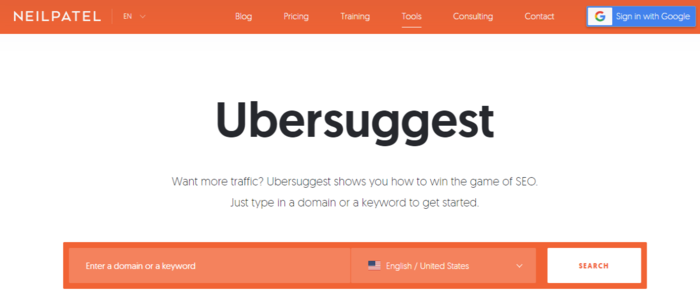
However, stopping at the right keywords to target is only half the battle, as keyword research is concerned.
You must also consider negative keywords.
These are keywords where you don’t want your ad to appear. That’s because negative keywords serve no purpose in helping you reach your goals. However, they can be dangerous as they could drive your ad spend up.
Tap Into the Local Culture
When creating the copy for your hyperlocal ads, tap into the local culture.
In short, leverage local stereotypes and incorporate local lingo if possible.
This will add a touch of personalization to your ad campaigns. As a result, your prospects will feel safe following your ad to your location.
Tapping into the local culture will also help your brand become acceptable as a relevant part of the community.
This can increase brand loyalty.
Ride on the Back of Your Competitors
When setting up your hyperlocal ad campaigns, your biggest help can come from the most unlikely source.
Yes, I mean your competitors.
How can they help you?
Easy.
Run campaigns in the vicinity of their locations.
Of course, for this strategy to work, you must be able to prove why you’re the better option. You can do this by pitching your unique value proposition (UVP) or by offering an incentive.
One of the best examples of this strategy is Burger King’s WhopperDetour campaign. Burger King drove traffic to their stores by offering app users Whopper sandwiches for a mere penny as long as they were in the vicinity (within 600 feet) of a McDonald’s.
The best thing about this strategy is that your ads will go out to people ready to make a purchase. Converting them into paying customers becomes a piece of cake.
Target Events Near You
People love events.
They love the excitement building up to an event that they’re planning on attending.
You can leverage that excitement by creating hyperlocal ad campaigns targeted at said events.
Not only will this help you get your target audience’s attention, but it will also help you leverage the excitement created by the event.
And every marketer knows that the happier a person is, the easier it is to sell to them.
Another advantage of targeting events is that they attract people from areas outside your location. This element helps increase your brand awareness beyond your geographical area.
Marry Hyperlocal Marketing With Out-of-Home Advertising
Considered the oldest form of hyperlocal marketing, out-of-home (OOH) advertising leverages display ads placed physically in the vicinity of your business. Examples of OOH include billboards and other forms of signage that can be used to grab attention and convey a marketing message to your audience.
While it may be old-school, OOH has moved with the times and is now digital. With the use of digital signage, you can continue your online hyperlocal marketing campaigns offline. This makes for a better customer journey that has higher chances of conversions.
Conclusion
Hyperlocal marketing is a great way to drive traffic to your brick-and-mortar business. Especially in this day and age when competition for customers is stiff, you need to up your game to achieve your marketing goals.
And hyperlocal marketing could just be the shot in the arm that your business needs.
While it may seem counterintuitive to market to a smaller target group, going hyperlocal has the advantage of improving your lead quality.
As a result, you reduce your cost per lead (CPL) while increasing your ROAS.
Now that’s definitely a win in any marketing playbook.
If you’ve run hyperlocal ad campaigns before, what was your experience with them like?
The post How to Create Hyperlocal Ad Campaigns appeared first on Neil Patel.
The Definitive Guide to Local SEO
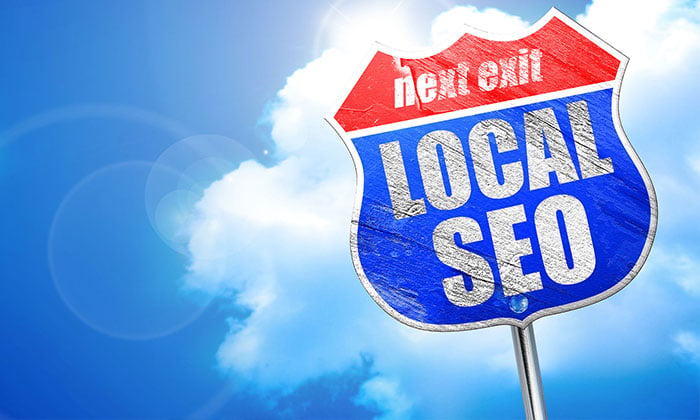
Local SEO is important.
In fact, 46% of all searches on Google are local.
That means if you’re a local business and you don’t have your local SEO in order, you’re missing an opportunity every time someone searches for your products or services online.
And there’s a lot of people searching.
About 89% of people search for a local business on their smartphone at least once a week, with 58% searching daily.
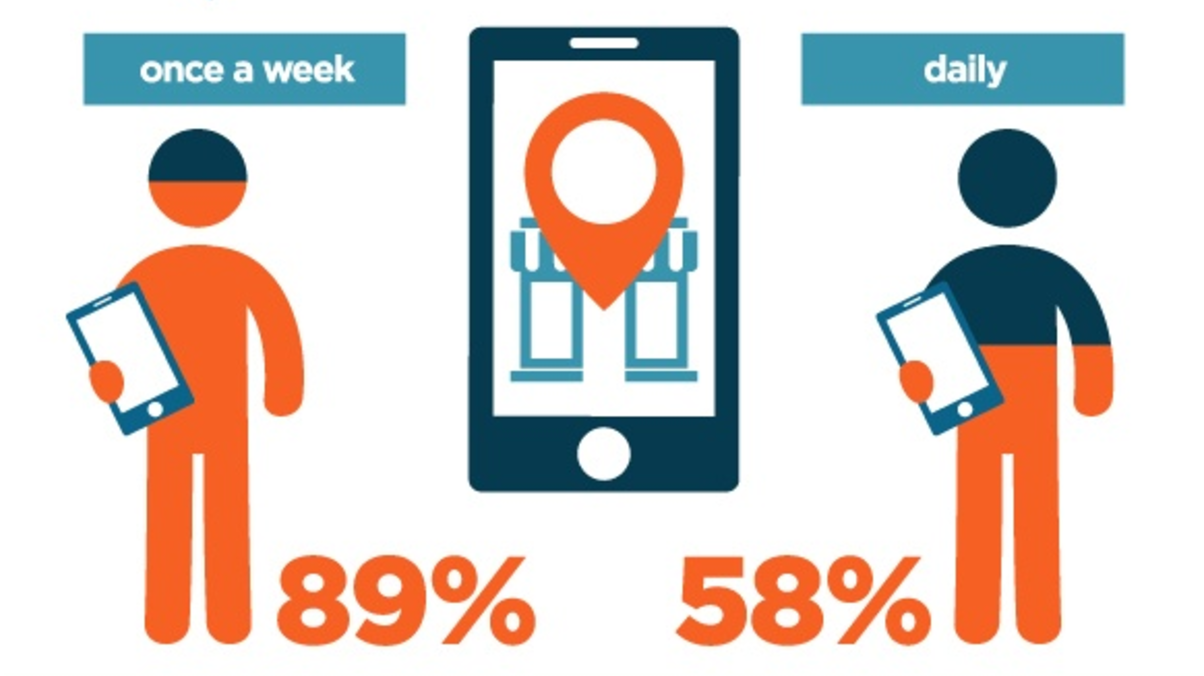
And from that search, 72% will visit a store within five miles.
These searchers are unlikely to find you if your local SEO is poor.
What, Exactly, Is Local SEO?
Local SEO is the practice of increasing the online visibility of local businesses. It’s similar organic SEO, but with an added geographical component.
Specifically, you’re aiming to rank high in the search engine result pages (SERPs) for local searches.
There’s no point in a New York restaurant ranking high in Houston’s local search results. They want people searching for restaurants in New York to find them.
So it’s imperative to improve your local SEO if you want to increase your organic local traffic.
According to Moz’s 2018 local search ranking factors, Google My Business Signals, including proximity, are a top ranking factor.
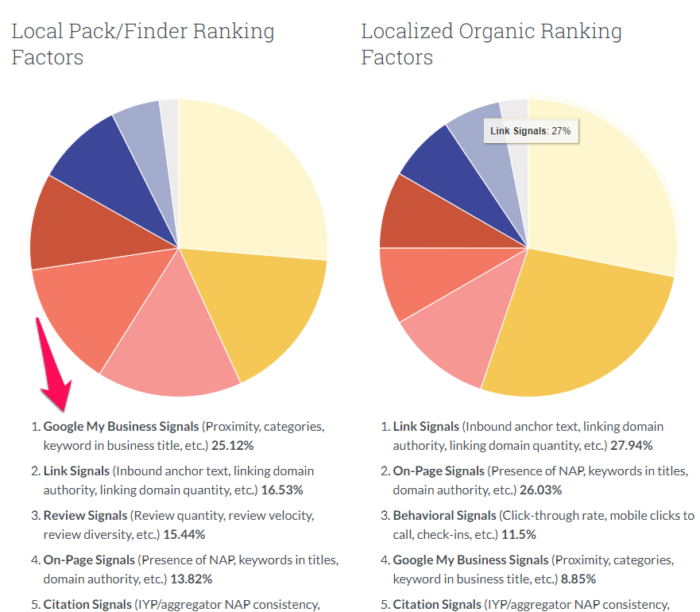
These are the signals that help local businesses rank in Google’s three-pack.
But what’s the “pack?”
The Google three-pack is the collection of the top three results for your local search.
This used to be a 7-pack, but it was truncated to be a better fit for mobile searches.
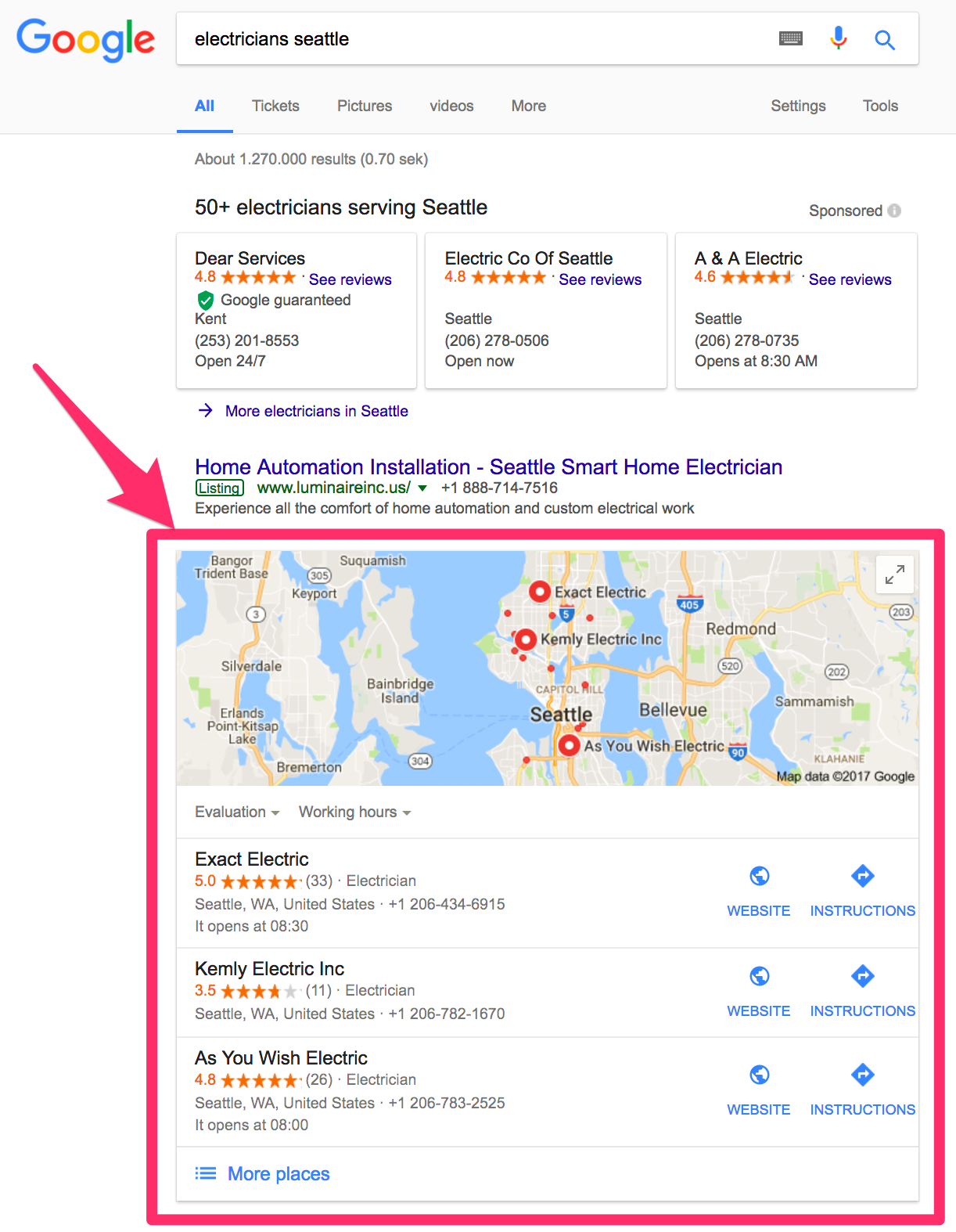
That’s where you want your business to sit.
So how do you get it there?
Here’s some local SEO tips that will get your business noticed.
1. Optimize Your Website for Local SEO
If your website isn’t properly optimized, it will be hard for you to climb the SERPs.
Check your website’s SEO now to see how it could be improved.
For local SEO, in addition to standard SEO best practices, you need to do the following:
Create a Dedicated Contact Page
These days, people want more detailed information about your business.
On your contact page, make sure you clearly show your “NAP:”
- Name
- Address
- Phone
I would also recommend that you display your email, like Seattle’s Velo Bike Shop has done on their site:

Include All of Your Business Addresses
If you have 10 or fewer locations, include the complete name, address, and phone number of each in the sitewide footer element on your website.
Make Phone Numbers Clickable on Mobile Devices
Some 30% of mobile searches are location-related.
So it’s vital that your site is optimized for mobile devices.
Also, 76% of local searches result in a phone call.
So make sure your phone number is clickable.
If someone finds your website on their mobile device and wants to call you, they might be annoyed to find they have to switch between apps to type in the number manually.
Here, Barrio Restaurant has ensured their phone number is clickable when viewed on mobile devices.
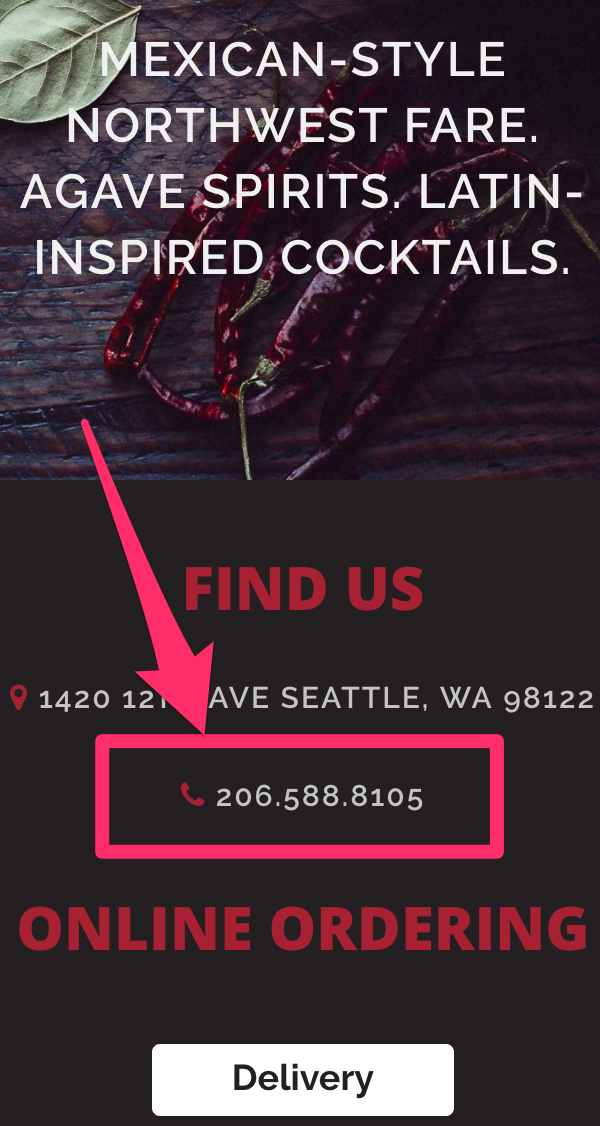
When the user clicks the phone number, their phone will prompt them if they’d like to call the number.

Google has a post that walks you through how to make a phone number clickable on your website.
Add a Map or Your Locations
The whole point of local SEO is to make it easier for people to find you, right?
So it would be silly not to add a map, especially when 86% of people look up the location of a business on Google Maps.
In this example, Starbucks gets it right, including an interactive map of all their locations.
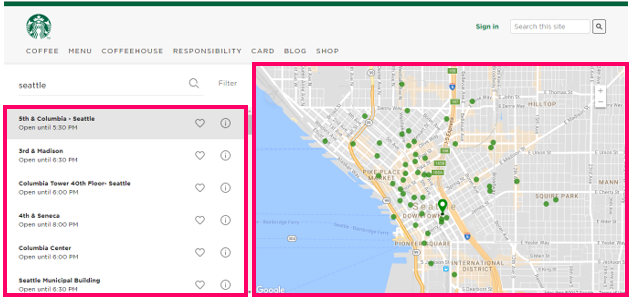
Add Testimonials
Google considers testimonials a trust signal, and it helps people feel confident that you are a real business.
And that’s why Local SEO Guide has a whole page dedicated to these types of reviews.
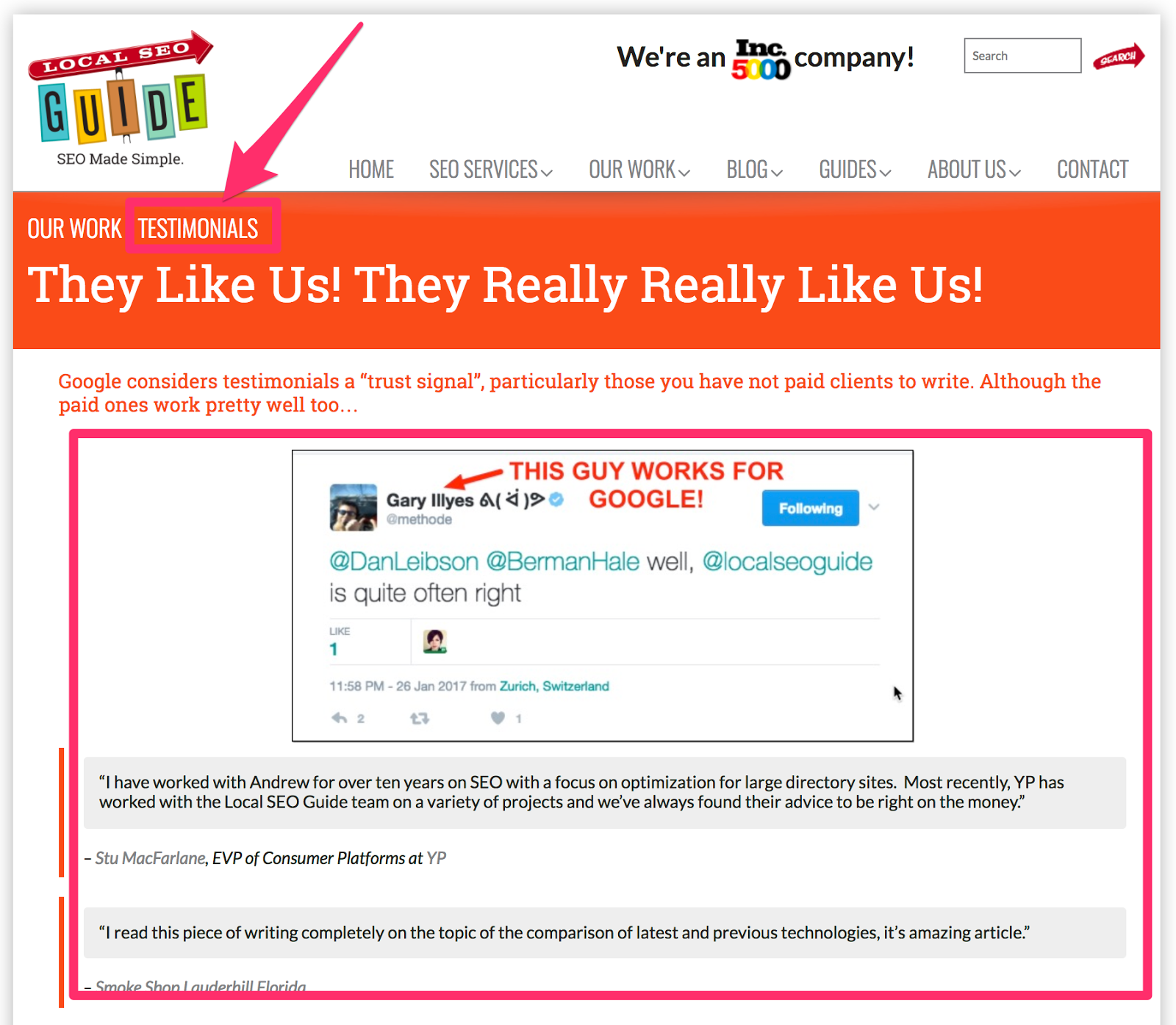
Collect and prominently display testimonials from local customers on your website for an added local SEO boost.
Add Schema
Schema.org was invented to create a common language between major search engines Google, Bing, and Yahoo.
It makes it easier for search engines to understand what your website is about.
By adding the appropriate Schema markup for local businesses to your website, you’re telling Google you’re a local business and not some big brand.
In turn, this can help to boost your local rankings.
To make this process easier, Hall Analysis has created a tool to help you create your Schema markup.
Just fill in your information, then copy the code on the right-hand side of the page.
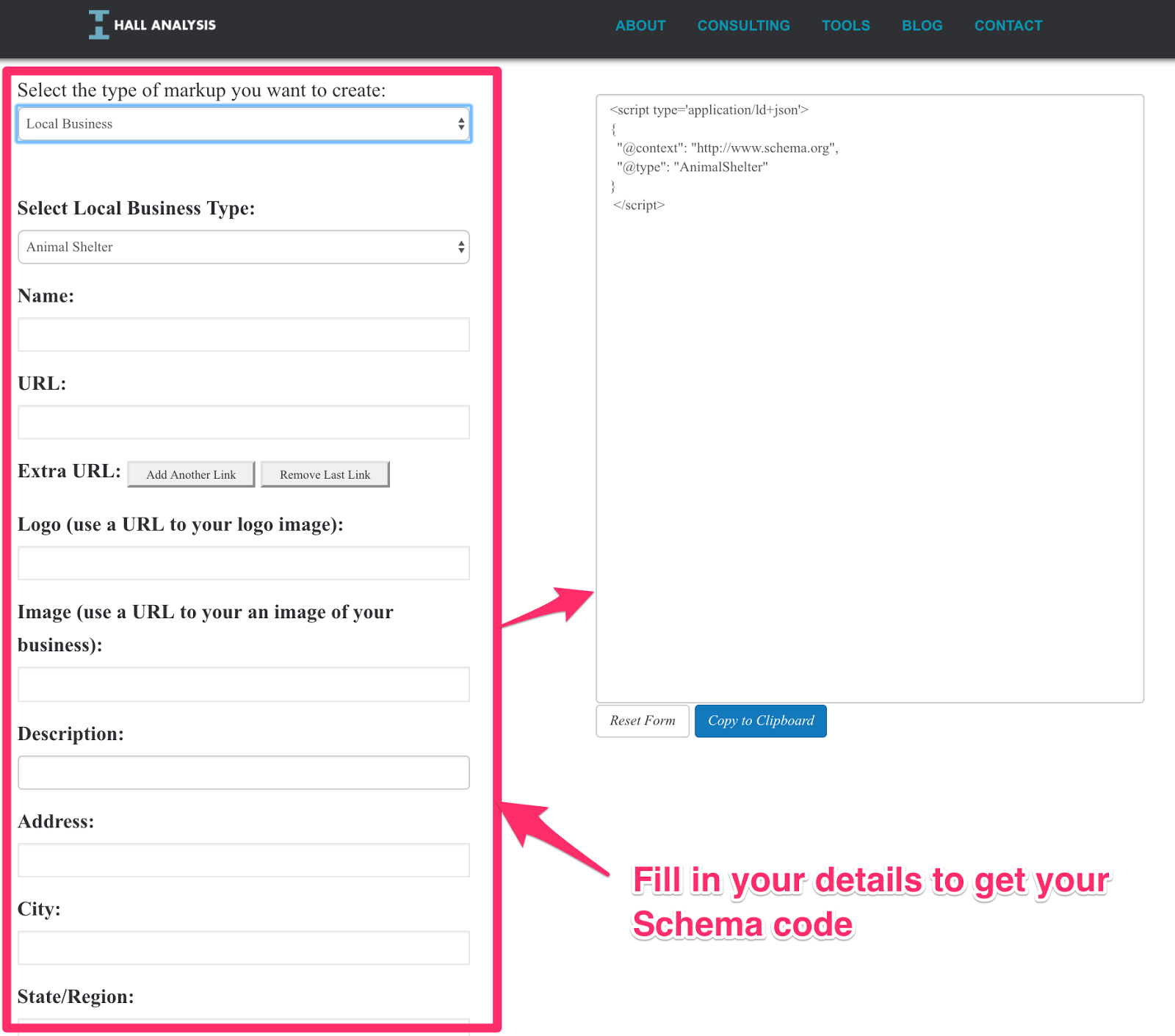
Next, paste the code in the <head> section of your HTML document or website builder.
After you’ve added your Schema markup, you’ll want to test it with Google’s structured data testing tool.
This tool should pull out your information, and show it on the right-hand side:
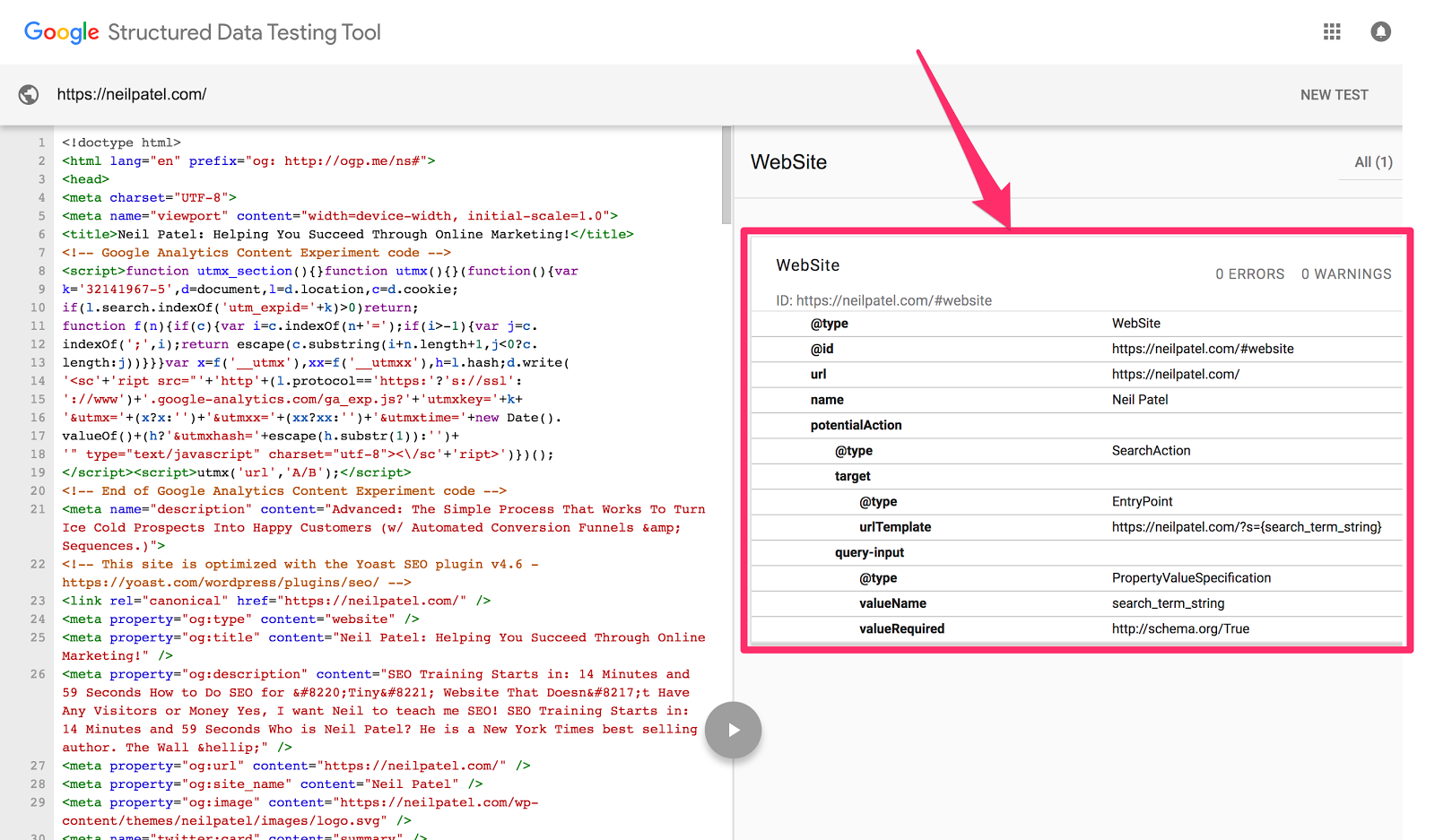
Once you’ve optimized your website for local SEO, you should be in a better position to improve your rankings and increase local organic traffic.
2. Claim Your Online Profiles – Especially Google My Business
Your website isn’t the only place you need to be online.
You need to make sure your business is properly listed on the main review platforms, like Google My Business, TripAdvisor, Yelp, and Facebook.
And don’t forget any popular local-review sites.
Why?
Because when it comes to local searches, Google’s 3-pack is often followed by these review sites:
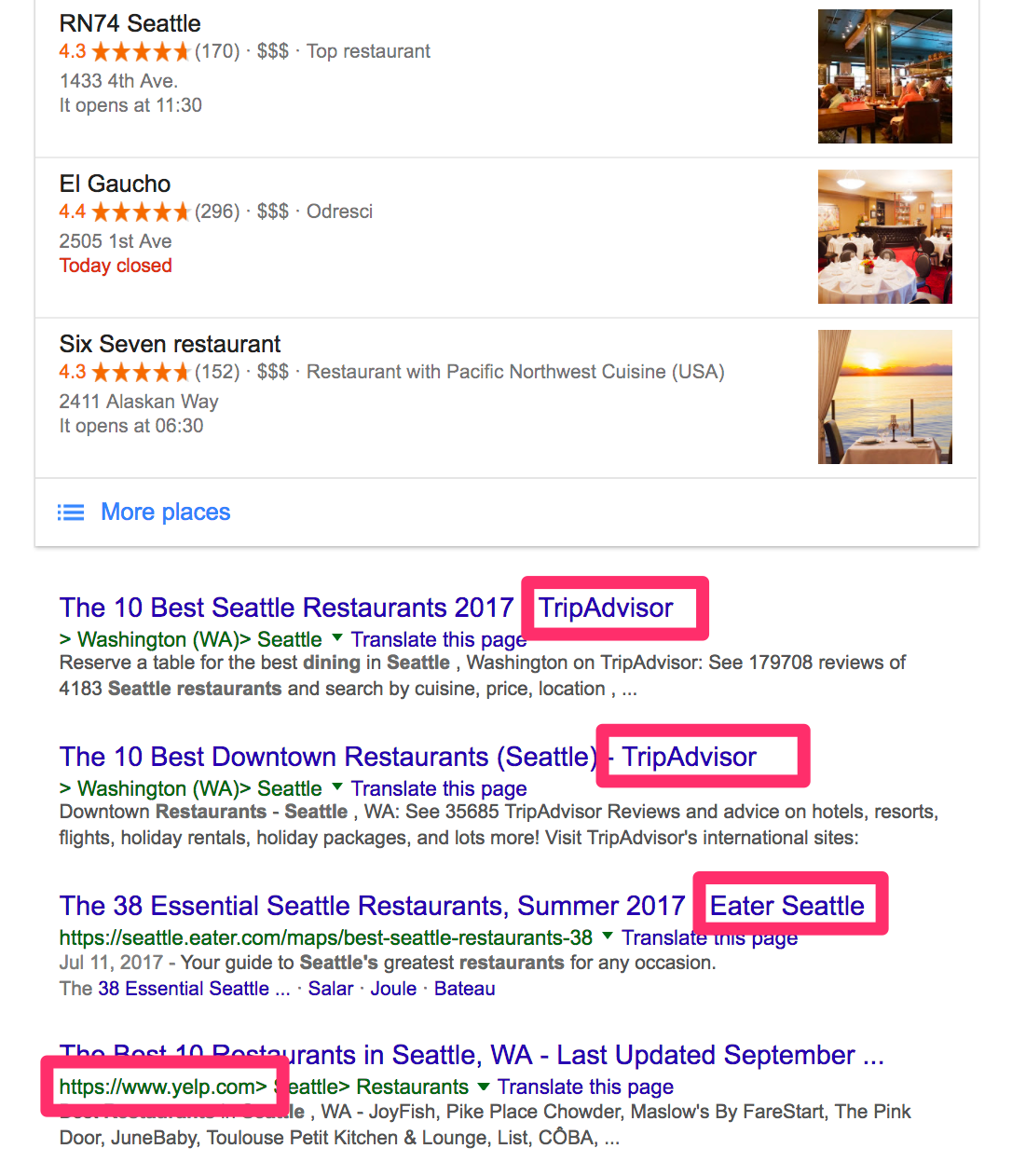
Google My Business
Filling out your profile on Google My Business is a good place to start.
This profile allows you to manage your presence on Google’s search engine.
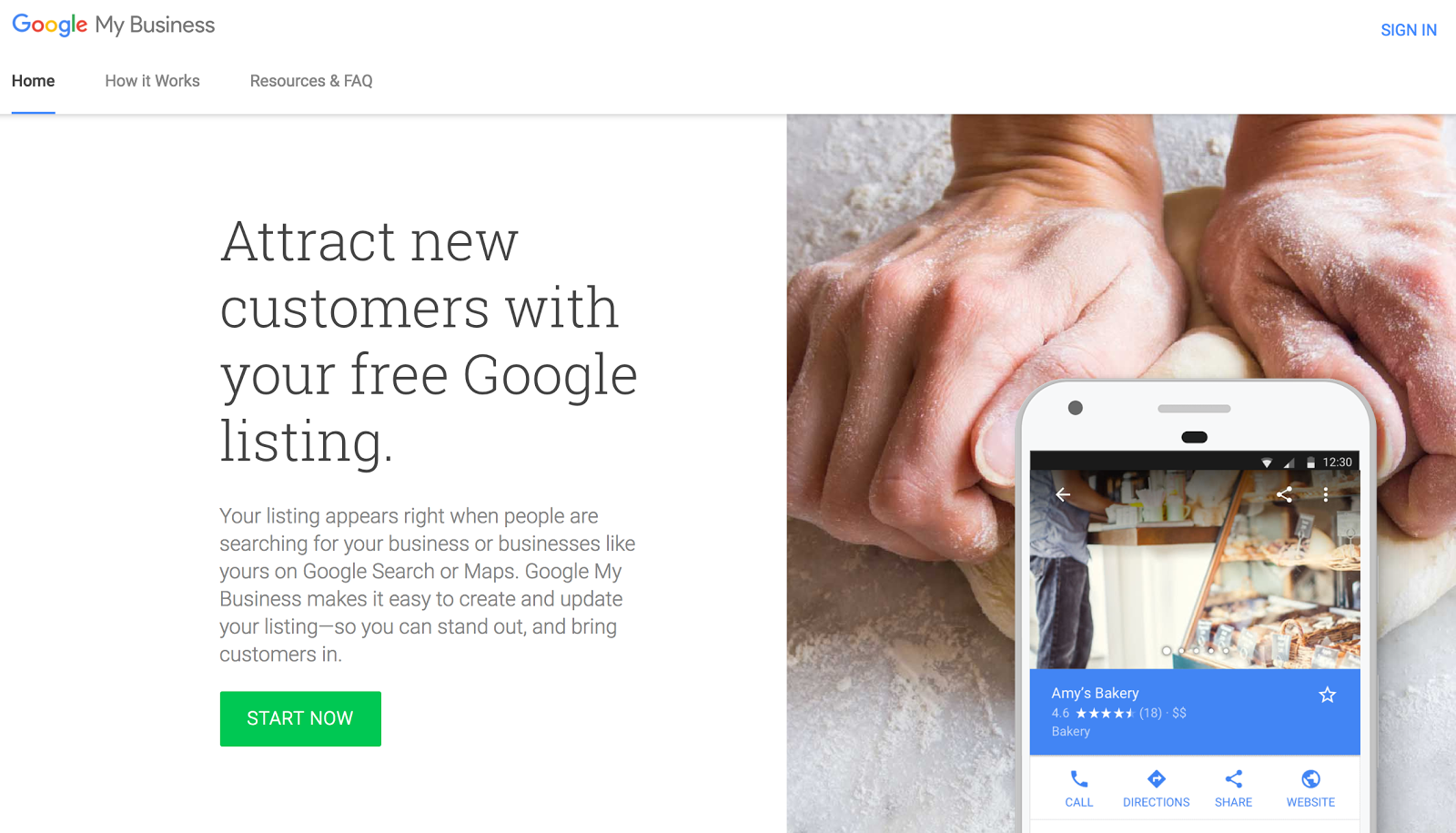
By filling out your profile completely and collecting reviews (which we’ll talk about in a minute), you’ll improve your ranking.
Google Maps will also show searchers a detailed profile of your business, like Seattle Coffee Works.
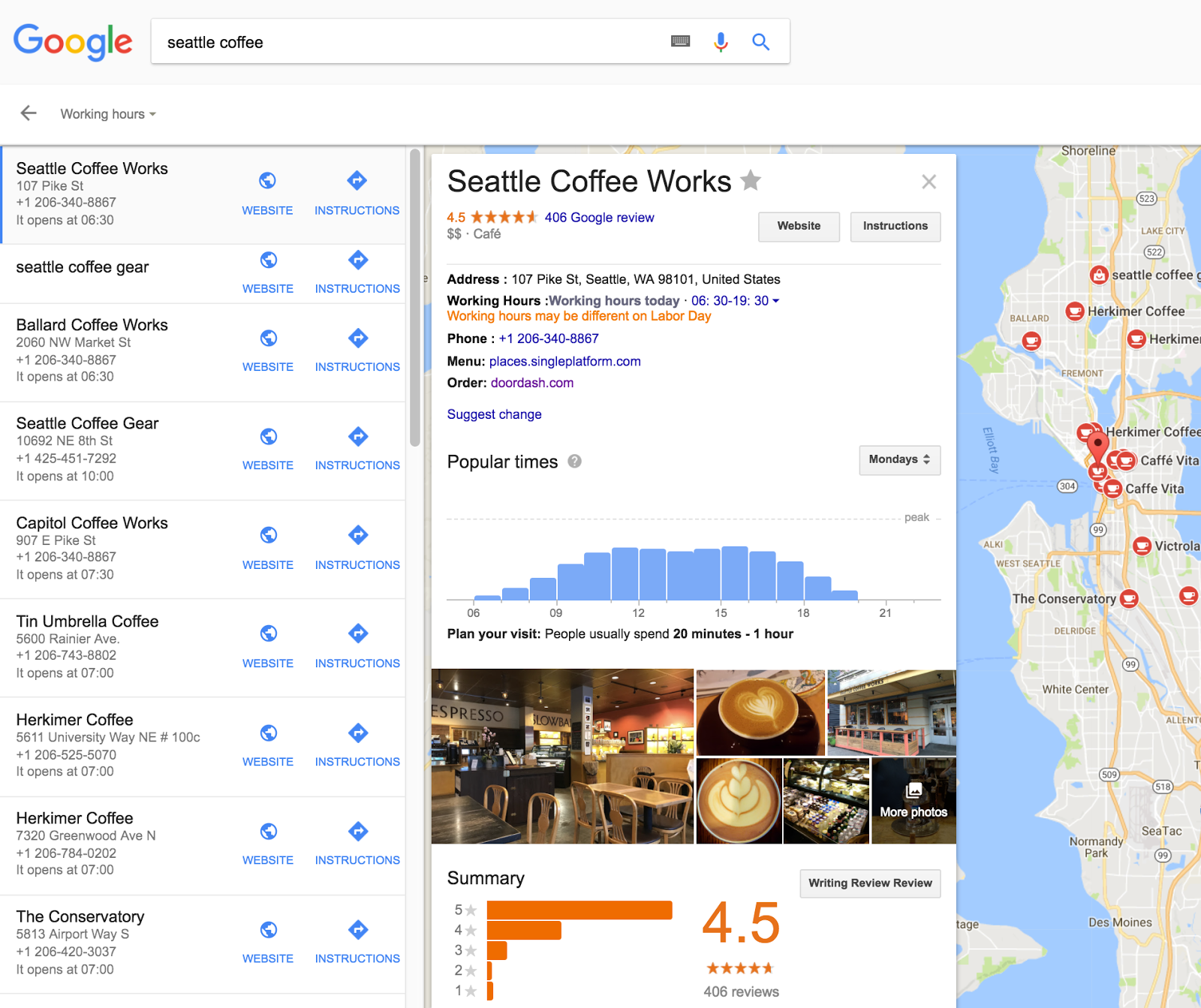
This is huge. So huge I wrote an entire post on how to optimize your Google My Business page.
Especially when you remember that 86% of people look up the location of a business on Google Maps.
Any Local Listings
You’ll often see the occasional local review site among the heavy hitters, like TripAdvisor and Yelp.
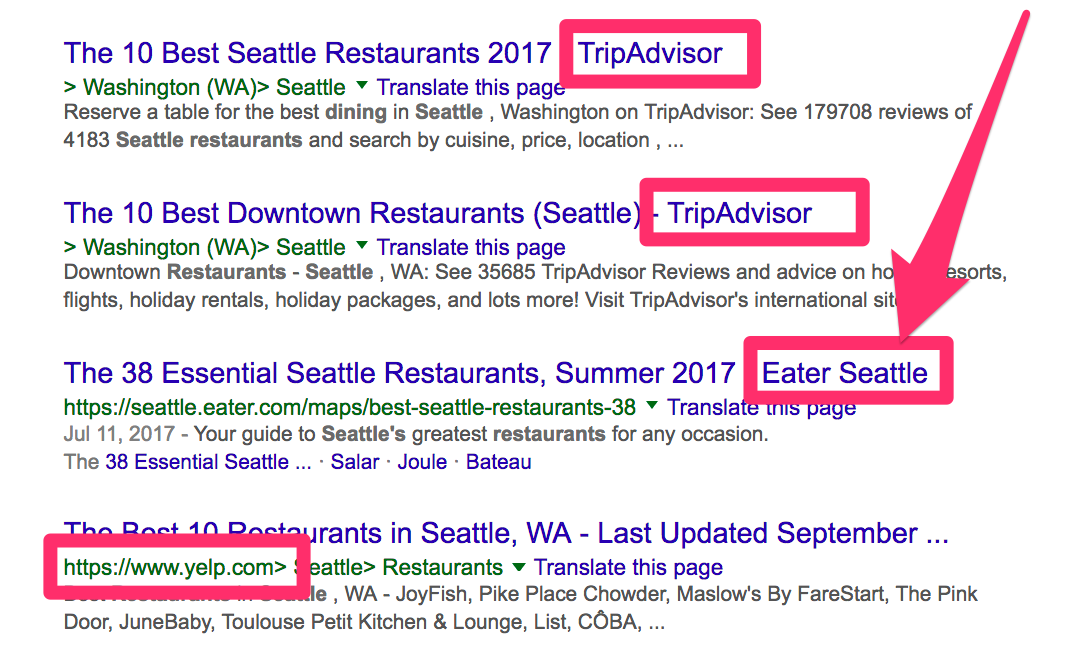
You can find the sites that are relevant to your business and location by searching keywords like:
- [target location] reviews
- [industry/niche] [target location] reviews
Claim Other Social Profiles to Improve Local SEO
You’ll also want to set up profiles on the social media channels relevant to your target demographic.
Be sure to follow social media best practices.
When setting up your profiles, it’s very important to make sure your information is identical on each platform.
Remember, consistency is key.
By setting up these profiles, you’ll become more visible to potential customers. You’ll also provide search engines with more information about your business, which will help to boost your ranking.
3. Create Local Content
Blogging is essential to SEO.
Just in case you haven’t already, create a blog on your website.
If possible, host your blog on your business’s domain for optimal SEO benefits.
For example, “www.website.com/blog” instead of “blog.website.com” or “websiteblog.com.”
Here’s Stonyfield’s blog:

This way, as you acquire links to your blog, you’ll also gain links to your business’s main site.
And if you remember the pie charts at the beginning of this article, links are the second most important localized organic-ranking factor.
So, as your blog’s search engine rankings increase, so do the rankings of your website.
When writing the posts, make sure to include local city and neighborhood names wherever you can.
Not everyone will use your city name when searching, so be sure you also include neighboring towns and cities, neighborhoods, and unofficial terms that locals may use.
Include local news and happenings, which will not only boost your SEO but will also provide useful information to your audience.
Capitalize on the popularity of an upcoming community event, election, fair, etc.
Or, sponsor local events, teams, or organizations, and write about them.
Try to cover local events from the perspective of a local business owner.
You can also interview local experts within or outside your company.
Here, Stonyfield gets involved in a local charity initiative.
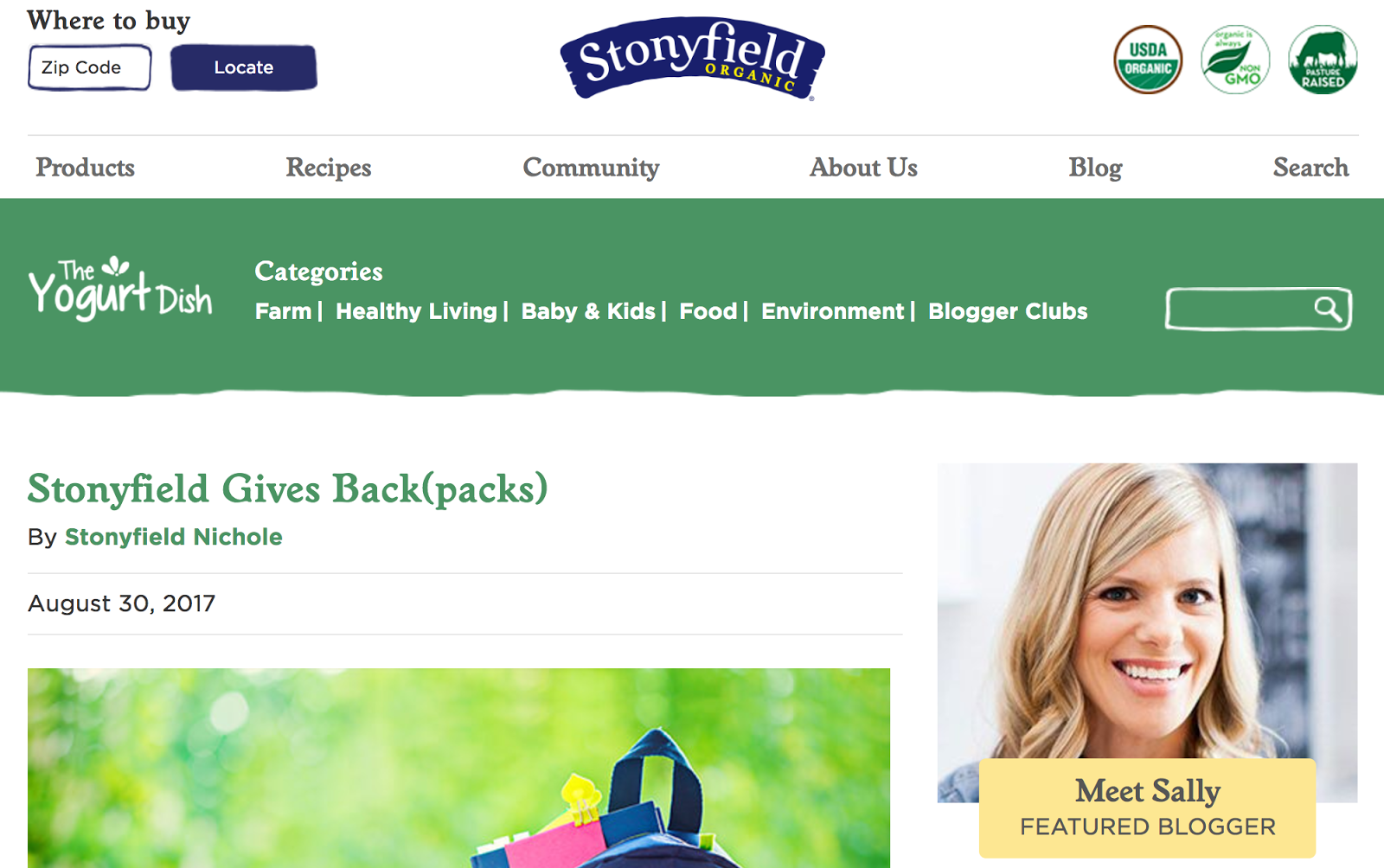
But don’t write about your business.
David Meerman Scott, an online marketing strategist, says it perfectly:
“Stop talking about your products and services. People don’t care about products and services; they care about themselves.”
Write posts that help and benefit your reader in some way. Aim to become a trusted source in your industry.
Here, none of Stonyfield’s most popular blog posts are about their business or products directly.
Instead, they are aimed at helping the reader in some way.

Build Links
While you build your blog audience, you also want to collect inbound links.
A good way to start is to join conversations in other local business blogs.
You might want to avoid direct competitors, but are there any complementary or related business blogs in your community?
Participate by leaving thoughtful comments or mentioning (and linking) their posts on your blog.
Building relationships with other businesses is a great way to establish your website and attract links back to your blog.
Another thing you can do is conduct a backlink audit of your top competitors. You can use Ubersuggest to do this. Here’s how.
Step #1: Enter your competitor’s URL and click “search.”
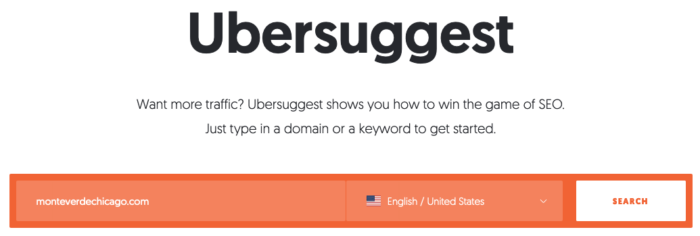
Step #2: Click “backlinks” in the left sidebar to conduct your audit.
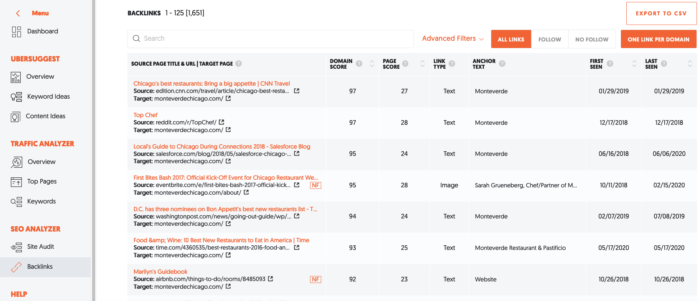
The final section of the results page lists every backlink, along with:
- Domain score: Measures the overall strength of the website, from 1 (low) to 100 (high)
- Page score: Measures the overall strength of the page, from 1 (low) to 100 (high)
- Link type: Text or image
- Anchor text: The clickable text that leads to your website
- First seen: The first time Ubersuggest robots identified the backlink
- Last seen: The last time Ubersuggest robots confirmed the backlink
So, if Monteverde Restaurant & Pastificio is one of your competitors, you should review every backlink with an eye toward two things:
- Quality (measured by domain score)
- Your ability to secure a link
Reach out to the same sites and tell them why they should link to your site, too. It’s hit or miss, but even if you only pick up a few backlinks it’s a step in the right direction.
Know Who You’re Targeting
If you don’t know who you’re writing for, it’s extremely difficult to create valuable content that hits the mark.
So once you’ve created your reader personas, you need to understand your target neighborhoods and their demographics.
Nielsen created an excellent tool called Zip Code Lookup to help you do just that.
Simply input your zip code, and you’ll receive information like the median income, age, and consumer spending.
The tool also provides a title summing up the area, like “Urban Elders” or “Aspiring A-Listers.”
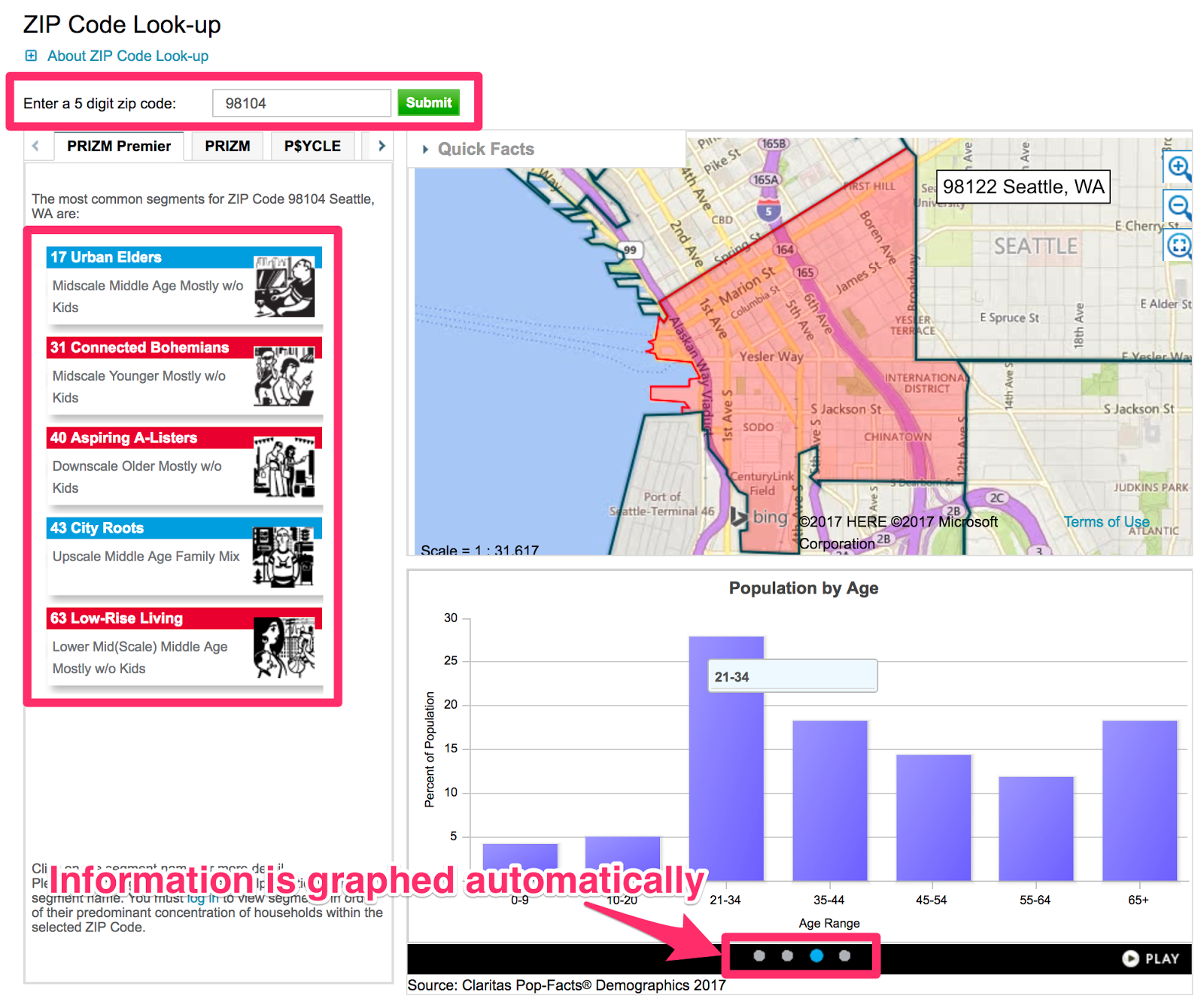
Local Content Mistakes to Avoid
Be sure to avoid common mistakes as you focus locally.
Don’t take content from other websites — even from your manufacturers — unless you’re using it as an attributed source or quote in your own original content.
Be wary of the multi-website approach for your business.
Many experts agree that it’s almost always better to build a single, strong website for your brand, its services, and branches, rather than splitting resources between multiple websites.
4. Get Reviews for a Local SEO Boost
Before the internet, it was easier for bad businesses to spin their branding and dupe customers.
Thankfully, the internet has put more power into consumers’ hands.
Now, everyone can instantly see whether you’re as good as you say you are.
Research shows that 81 percent of people read reviews and check ratings, and more than one-in-three consumers comment on blogs or contribute to online forums.

What’s more, 97% say customer reviews factor into their buying decisions.
So, basically everyone.
What’s the state of your online reviews?
If you have anything other than a four- or five-star rating on the major review sites, you might be in trouble.
Poor ratings turn potential customers off. And a lack of ratings may not instill trust and confidence in your brand.
However, a Harvard Business School study found that even bumping up your score by one star can help boost revenues by almost 10%.
Reviews also stand out to prospects as they’re often featured in local search results.
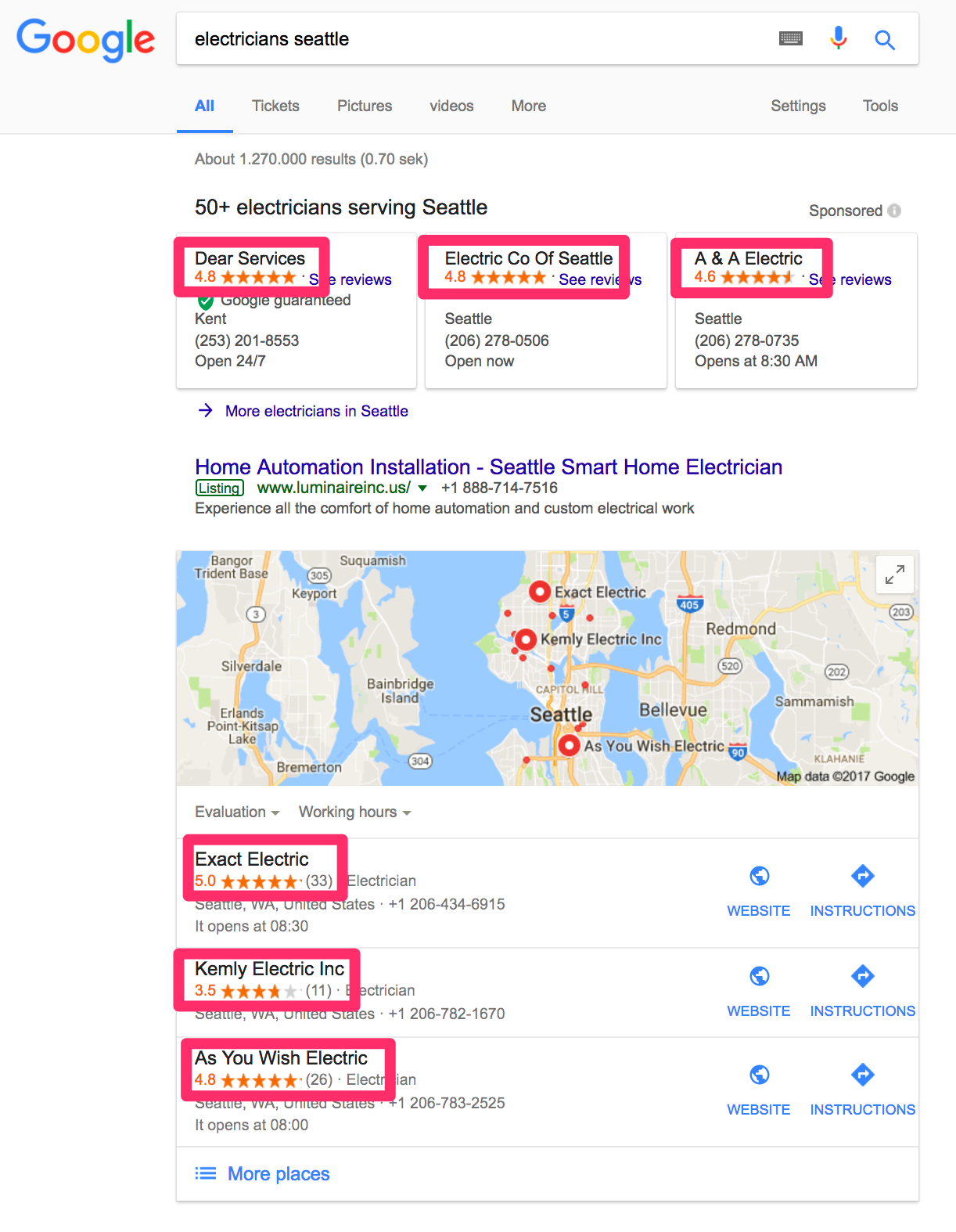
They actually make up 15% of the local pack-ranking factors.
Acquiring reviews is an ongoing process and one you’ll be engaged in for the life of your business.
Every business will receive negative reviews at some point along the way.
When you do, be sure to respond professionally and personally.
The best way to prevent negative reviews is to provide an incredible product or service.
By delighting your customers, you’ll limit bad reviews and encourage good ones.
So now that you’ve gotten your business properly listed on the main review platforms, it’s time to fill them with positive customer reviews and photos, like The Station:
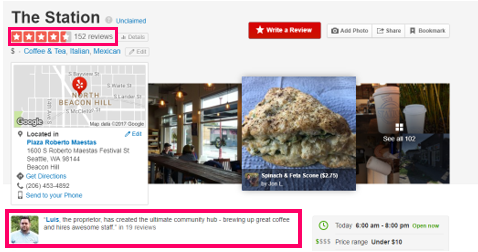
According to Moz, Google reviews are believed to have the greatest impact on Google’s local rankings.
You can create a shareable Google review link to promote to your audience here.
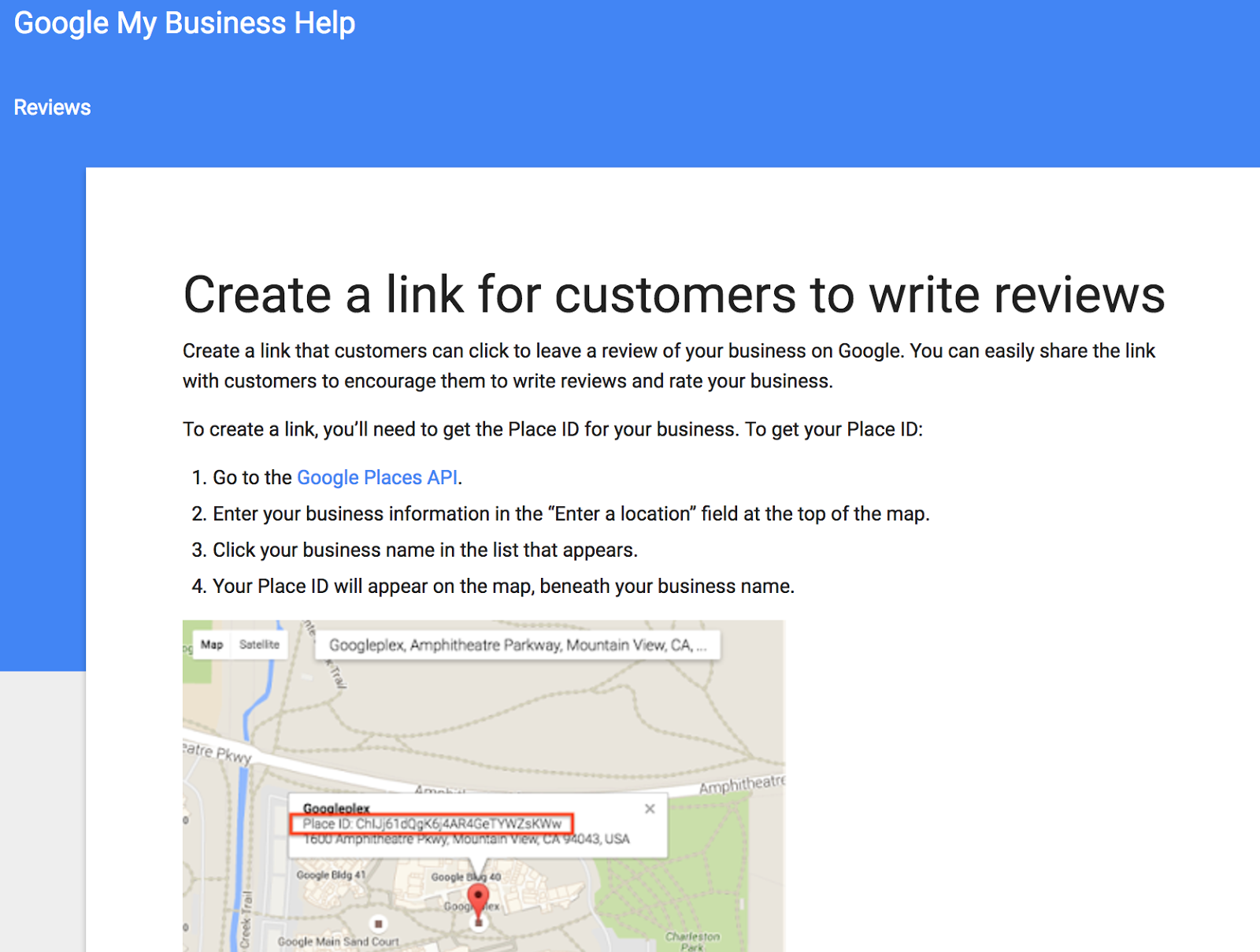
Things to Avoid When Asking for Online Reviews
Before you start asking for reviews on any platform, make sure you know its guidelines and terms of service.
For instance, Google doesn’t permit you to offer incentives in exchange for reviews, and Yelp forbids businesses to request customer reviews in any way.
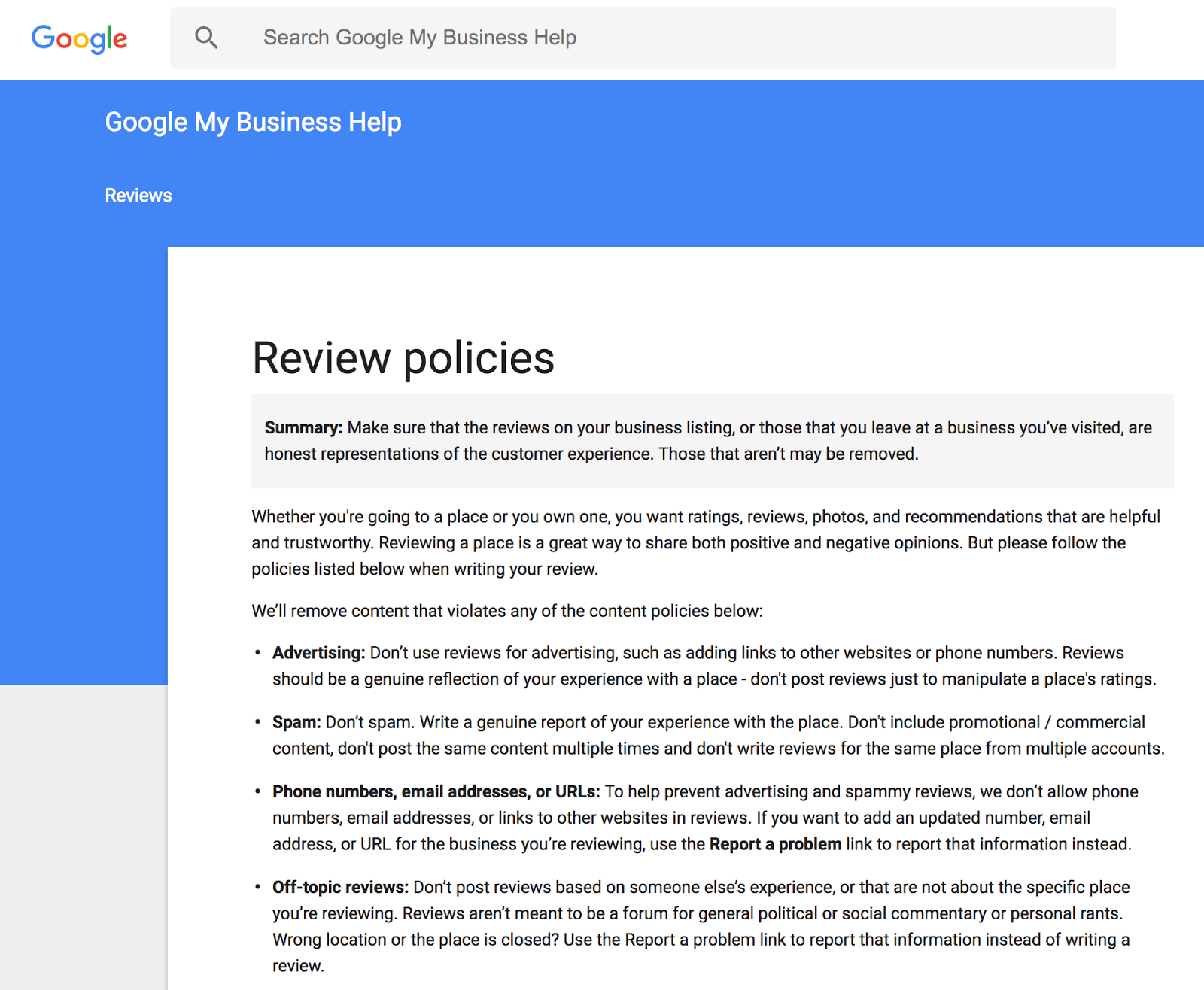
You want to channel your customer’s positivity to influence new potential customers.
What goes around comes around, right?
So don’t do anything pushy, like set up a review station or kiosk to ask for reviews.
Make sure to have local customers leave reviews using their own devices and under their own accounts.
Also, don’t ask for too many reviews at once. A sudden influx of positive reviews can look suspicious and may result in filtering on some platforms.
Once more, acquiring reviews should be a steady, ongoing process for your business.
5. Build Citations for Local SEO
What exactly are citations?
They’re mentions of your business name, address, phone number, or website (NAP+W) anywhere on the web, even if there is no link to your website.
Citations are important to your local SEO efforts because its signals make up 11% of local pack-ranking factors.
Make sure you only build citations for real physical locations, as P.O. boxes and virtual offices are not acceptable.
You can build a unique set of citations for every physical location you have.
But make sure the name, address, phone number, and website URL are correct and identical on each citation you build.
As I’ve mentioned in a previous article, mismatched NAP account for 41% of the total ranking issues.
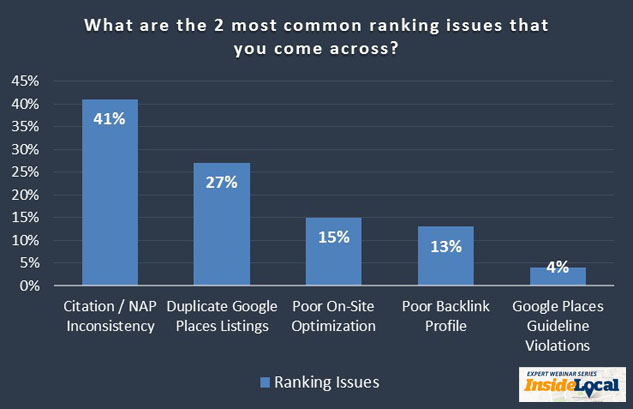
So once again, consistency is key.
That said, search engine algorithms are clever enough to understand most abbreviations.
It’s important to check whether your abbreviation will be picked up and read correctly by search engines.
For a full list of acceptable abbreviations, check out Whitespark’s complete table.
Here are some ways to build citations.
Local Search Engines
Search engines like Google or Bing crawl the web for citations to validate or update the information in their own indexes.
You can help the search engines do this by listing your businesses on sites like Yelp, Hotfrog, and Foursquare. (Though it’s worth noting that FourSquare’s city guide is much less popular these days.)
Dedicate some time and resources to making sure your business is listed in as many relevant, quality local business directories as possible.
Local Blogs
Local blogs are a fantastic place to get your business listed to boost your local SEO.
These blogs are well-indexed by search engines and are highly associated with a particular city, region, or neighborhood.
As you acquire links from these blogs, search engines will increasingly view your business as trusted and relevant in the local search engines.
Local blogs will be different for each location, but you can find ones relevant to you and your business by searching terms like:
- [target location] [niche/industry] blog
Often, the top local blogs will have the name of the city or region in their title or domain, like Seattle Theatre.

Locally Focused Directories
Like local blogs, local directories are strongly associated with a geographic area and they’re well indexed by search engines.
Directories edited by a human are preferred.
This is because they’re less susceptible to spam, so they tend to be more trusted by the local search engines.
To start with, add your business to Best of the Web’s Regional Directory.
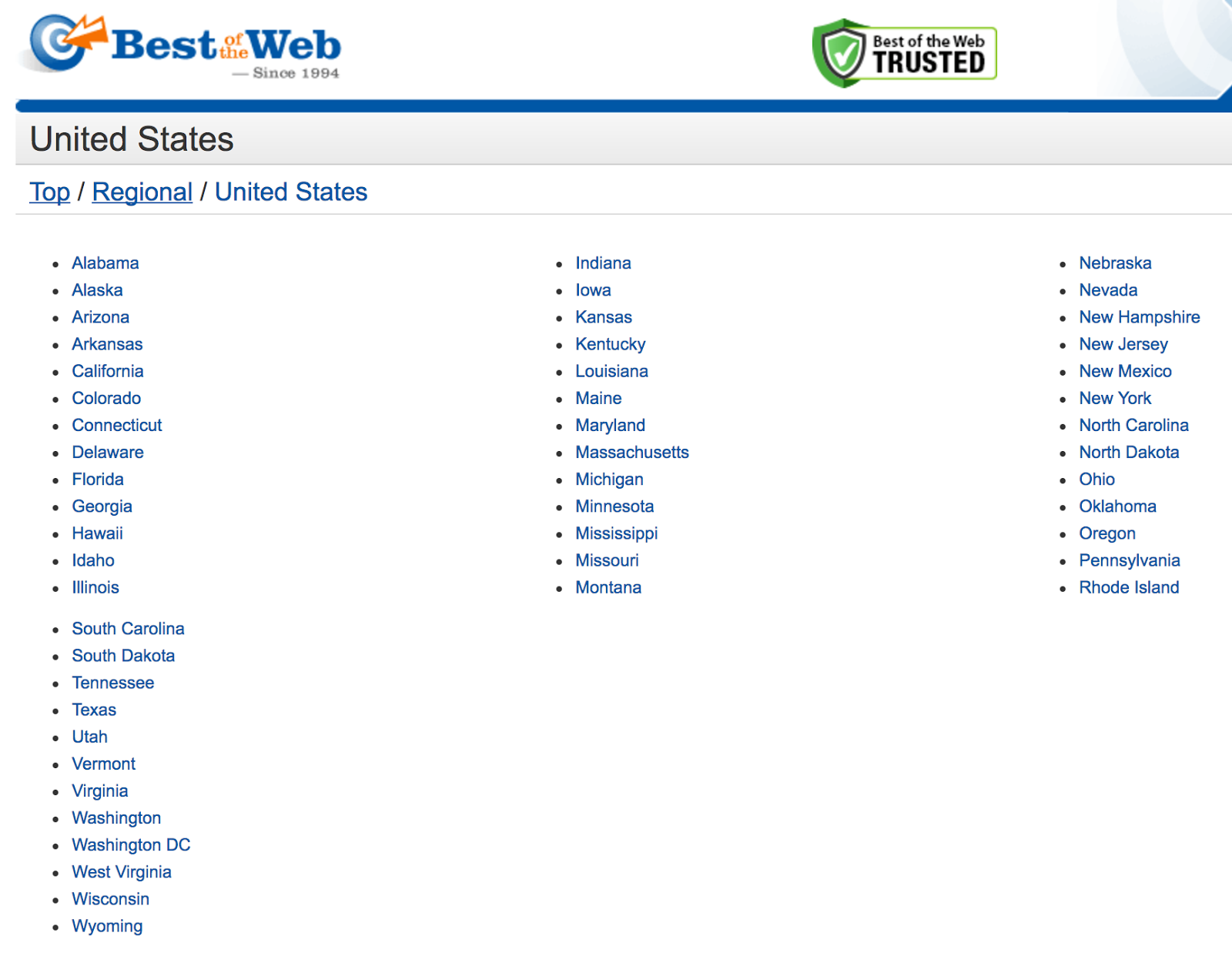
Then you can search for specific local directories by using search terms like:
- [Target city] directory
- [State] directory
Industry-Focused Directories or Blogs
You can also gain citations from industry focused blogs and directories.
These websites are focused on the topics and keywords related to your products and services.
Although these sites don’t always have a local focus, they may be counted as citation sources by local search engines.
Do you have a membership directory for your trade organization or a blog that’s popular among readers in your niche?
Both are likely to be crawled by the local search engines for citations.
Porch is a directory of local contractors like painters, plumbers, and electricians.
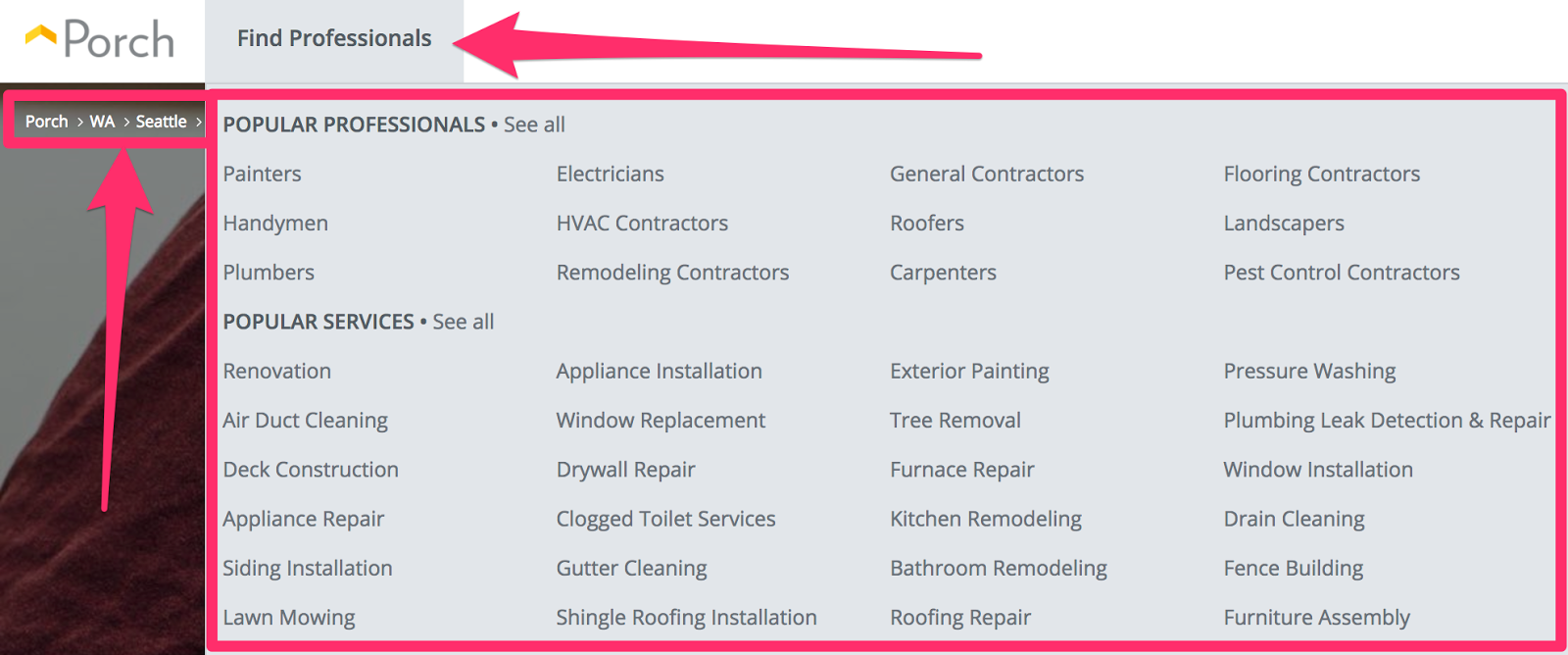
You can find industry directories and blogs relevant to your business by searching terms like:
- [your industry] directory
- [your keyword] directory
- Top [your industry] blogs
Conclusion
Fighting to climb the SERPs can be tough for businesses, especially if you’re a small business with limited resources.
But local SEO is critical to your business success.
As people rely more and more on search engines and reviews to find what they need, you’ll need to boost your local rankings to be found.
So climb the local SERPs by optimizing your website, producing great local content, acquiring citations, and earning reviews.
But, don’t limit yourself to technical local SEO practices like citations and web optimization, though.
Build relationships with other relevant local business, participate in community events, and join local organizations.
Local SEO isn’t a stand-alone endeavor. You also need to use SEO and social media marketing to boost your rankings.
Online efforts are always a reflection of offline realities. If your business is bad, your reviews will be, too.
So, focus on building the best business you can.
What local SEO techniques have produced great results for your business?
The post The Definitive Guide to Local SEO appeared first on Neil Patel.
source https://neilpatel.com/blog/definitive-guide-local-seo/
The 5 Benefits of E-Commerce Automation

Running an e-commerce store is a lot of work, but you already know that. You’re experiencing it every day, from marketing and communication to fulfillment and shipping, not to mention all the follow-up. And everything else in between. Sometimes it can feel like you’re doing so many little things just to keep the business going, so you don’t have time to focus on the big picture, taking your business to the next level.
That’s where e-commerce automation comes in. What if things just happened, without all the legwork each time? E-commerce automation is the magic sauce to free you from the mundane.
What is E-Commerce Automation?
We’ve talked about automated e-commerce emails before, so you may be familiar with that option, but when it comes to e-commerce automation, the sky’s the limit.
E-commerce automation is any digital or technologically-driven task triggered by an action or non-action from a customer, your team, etc.
In simplified terms, it’s a task happening automatically, using software or online systems, without human intervention. You set it up, and it runs.
For example, in marketing, certain ads or emails are triggered to go to target audiences.
In sales, customers with empty carts can receive a reminder message. Shoppers with questions are offered a chatbot.
In fulfillment, orders can trigger messages to help you manage inventory, including “sold out” notifications.
The list goes on.
How Can E-Commerce Automation Help My Business?
More and more people are shopping online, giving e-commerce the advantage over brick-and-mortar stores. Meanwhile, Forbes reports that consumers have increased expectations for faster and more convenient deliveries. To stay competitive, business owners must find ways to move faster and stay nimble.
E-Commerce Automation Saves Time
Automating repetitive tasks can suddenly free up time. If you don’t have to track remembering to do them and making them happen, imagine what you could do with the extra time.
Think about those mundane tasks you have to do over and over again, including data entry, customer emails, social media, and more. The more you can automate, the more gets done even without you.
With e-commerce automation, you can schedule sales promotions to go live at the right time, automate new product releases with their announcements, remove discontinued products, adjust prices, apply discounts, track purchases and provide rewards, etc.
But it’s more than getting the actual tasks done. E-commerce automation can do them better in many cases, saving you from having to go back and correct errors. When data is sent from one platform to the other, the chances of human error are lessened. Although, it’s never a bad idea to go back and check in periodically to fix any mistakes.
E-Commerce Automation Increases Worker Engagement
What if you could announce to your team tomorrow, “Good news. That mundane task sucking the life out of you every Monday? It’s gone.” You’d probably increase employee satisfaction, right?
That’s exactly what e-commerce automation can do for your whole team. Instead of having to do data entry every morning, they can just check in with the system periodically, as it makes sense.
Now they are free to do the big picture stuff they came on board for: strategy, learning, growth in their fields. It could breathe new energy and excitement into the team.
E-Commerce Automation Helps Customer Satisfaction
Happy customers are more likely to be repeat customers. New customers can cost you about five times more than selling to repeat customers, according to Invesp. E-commerce automation can help you keep customers happy, and turn them into repeat customers, even as you scale to reach a greater audience.
Yes, it’s easy to stay engaged with customers when you have a handful, but what happens when you have hundreds, thousands, and more? You just can’t be there for all of them.
As you automate things, you can improve the customer experience at your shop. Customers can find what they are looking for more quickly and purchase what they want more easily, while not being bogged down by unavailable products, etc.
Easier Onboarding With E-Commerce Automation
As with customers, keeping suppliers happy in their interaction with your brand is key to profitable long-term relationships. Various e-commerce automations can keep the relationship engaging and moving forward.
Automated supplier portals can give employees more time to focus on company growth, as we discussed above. Meanwhile, new vendors and suppliers can take the lead in setting themselves up in your system. Of course, you’ll want to be there for questions and customer service, although much of that can be automated as well. Vendors will appreciate the system moving quickly and seamlessly without relying on human intervention throughout the process. Since the vendors and suppliers are in charge of their orders and requests, nothing gets lost in translation.
Fewer opportunities for error and fewer problems with supplier/vendor relationships mean you can get back to the business of growth and wowing the world with your brand.
Simpler Deliveries With E-Commerce Automation
Is there anything worse than lost or misdirected packages after you place an order?
E-commerce automation systems process orders directly from the customer, printing receipts and shipping labels rather than having a person type them manually, which saves time and prevents the recurrence of mistakes.
As customers make package tracking a priority, businesses need to know where packages are for customer service and quality assurance purposes. E-commerce automation options can communicate tracking information automatically.
How Do I Know What to Use E-Commerce Automation for?
Now that we’ve shared the reasons your business can’t go on without at least some automation, how do you even know where to start?
It’s true the options are seemingly endless, so before we dive into some examples of great products you could be using to automate your e-commerce store, let’s look at how to decide.
Find the Pain Points
Where is your workflow bottling? If you’re unsure, reflect on issues customers have reported and feedback you’ve received from your employees. Those are the needs to address first, to leave the biggest impact. If you see needs in a couple of different areas, look for e-commerce automation systems to cover where those issues intersect. For instance, maybe you need a better CRM tool to help you improve customer communication before and after a sale.
Analyze the Big Picture
It can be difficult when you’re in the weeds of your business, but looking at the big picture can show you where the holes are. Which areas of growth are constantly being held back? What are you trying to launch that just keeps getting stymied? Integrating e-commerce automation can free up time and energy in those areas for deeper strategic thinking, research, experimentation, and, hopefully, growth.
When in Doubt, Start With Communication
If you’re still unsure where to begin, marketing e-commerce automation can be a great place to start. There are opportunities throughout the sales funnel, from the top when you’re first connecting with a prospect to converting a new user, as well as reselling and upselling to existing customers. Communicating authentically using automation is almost a no-brainer.
What E-Commerce Automation Tools Should I Use for My Business?
It may take some experimenting, but we’ve found these programs may be worth exploring. While there are countless options available, these tend to be popular across many industries.
ZenDesk
If customer service or sales communications is where you see the bottleneck, ZenDesk may have the solutions you need to integrate both internally and in your customer outreach. There are two main facets of ZenDesk, with lots of customizable choices in each platform.
ZenDesk Support Suite
You may have encountered the ZenDesk support features already through a brand you’ve been researching online. Many customers may not need to speak directly to someone at your company to get their questions answered. You can create a robust, interactive FAQ section.
You can also create customer service layers, from self-service to live chat with a customer service agent. One of the powers of the ZenDesk support suite is the omnichannel options. You can set up the system for customers to send in their questions or concerns via email, text, or live chat on your website, and other channels.
In addition, you’ll have access to customer service reports to help you understand what people are asking, how often, and how long it’s taking to get to a resolution. From there, you can tighten up your processes to improve the customer experience.
Mailchimp
Mailchimp sends e-newsletters, right? Well, when it comes to automation, they can do much more. Imagine sending just the right communication to just the right kind of customers, and you’re just scratching the surface of how Mailchimp can revitalize your marketing efforts.
Through “Customer Journeys” you can create a series of emails to go out to target markets, depending on any number of trigger points, including interaction on your website or when connecting with your customer service or sales teams.
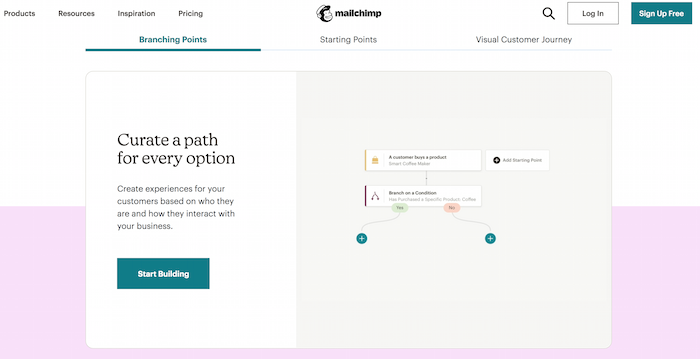
Once they’ve made that purchase, there are so many more ways you can be connecting with them using Mailchimp. Shipping and delivery notifications, how-tos and suggestions, follow-up and feedback are just a few of the marketing automation emails you could be sending.
Keap
Keap is an all-in-one e-commerce solution with a focus on helping service-based small businesses succeed with automation. They offer templates e-commerce companies can use to create automated email blasts, reminders, and lost lead actions to grow your sales and build customer loyalty.
They are a great option to explore if you’ve found your business is being held together with Post-it notes, spreadsheets, and scraps of paper you can’t keep losing. Keap pulls it all together, from your existing client base to prospect CRM, to all your communications, invoices, quotes, and more.
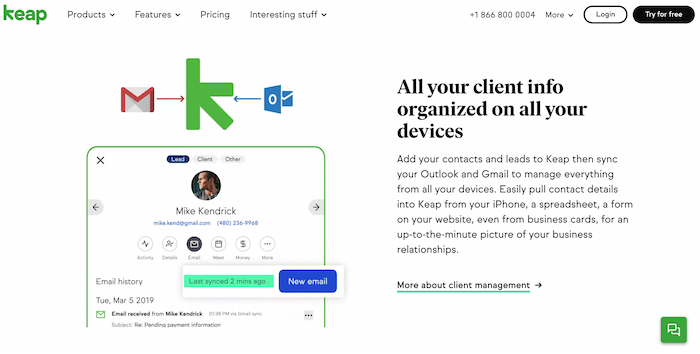
By keeping everything in Keap, you can feel more confident that you aren’t going to lose an opportunity or overlook a client.
HubSpot
HubSpot is a powerful tool that we’ve discussed before for any business looking to scale. While there is a paid version that may be out of the price range for many, HubSpot offers several features for free.
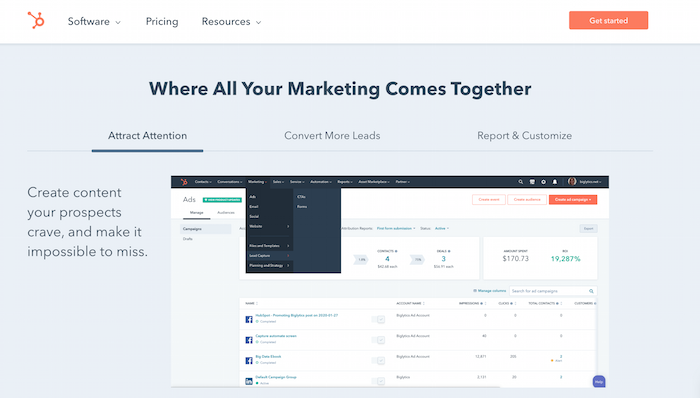
HubSpot’s tools include the Marketing Hub, Sales Hub, Service Hub, and Content Management System Hub. The free features can allow you to email templates, set up customer service ticketing, generate new leads, and create smart content.
Shopify
Shopify not only comes with many automation options through Shopify Flow, but you can also connect various integrations through their app store.
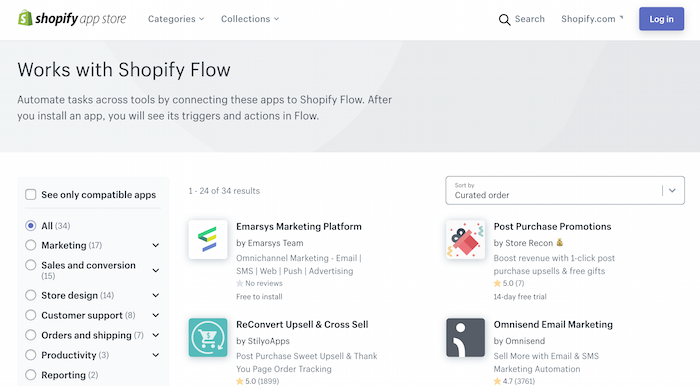
If you aren’t already using an e-commerce platform like Shopify, you may want to consider the benefits of having all your information right there in one place. As you grow, utilize more of the Shopify Flow options and integrations to take advantage of their systems.
Conclusion
After reading all of this information about what e-commerce automation can do for your company, you may be overwhelmed. If you are suffering from paralysis by analysis, remember this is about saving you time. Time you can use on bigger or better things.
Don’t get lost in all the bells and whistles clamoring for your attention. Choose the process that needs attention first and will help you boost your e-commerce sales. Then find the automation tool that seems most intuitive for you. Dive in and start saving time.
What’s the next e-commerce task you’re ready to automate?
The post The 5 Benefits of E-Commerce Automation appeared first on Neil Patel.
8 Tips For Creating a More Effective Case Study – With Examples

Case studies go beyond simple testimonials by providing real-life examples of how your brand satisfied your customer’s needs and helped them accomplish their goals.
An in-depth case study helps you highlight your successes in a way that will help your ideal potential customer become your next customer. They help you show rather than tell prospective customers how you can help them reach their goals.
But, creating a solid case study can be a challenge. Today, I’ll provide actionable tips to help you write a case study, provide background information, and identify key metrics that will help your case study drive conversions.
1. Write About Someone Your Ideal Customer Can Relate To
Do you know who your ideal customer is? If it’s someone in the education industry, then make your case studies about your university customers. If it’s someone in the automobile industry, then make your case studies about auto parts and accessories manufacturers.
The goal is to ensure that your case study will show prospective customers that you are:
- Comfortable in their industry.
- Undertand their industry’s specific needs.
- Know how to give their industry targeted results.
Think about it on a smaller level, such as when you’re reading a how-to blog post. Most of of these posts are geared toward average readers.
But when you come across a post designed specifically for your needs (such as online marketing for the healthcare industry), you are more likely to understand and apply the information.
The same goes with case studies – people who read about results in their industry will feel like the same approach will work for them.
2. Tell the Story from Start to Finish
Storytelling is a powerful marketing strategy. A great case study will allow someone to really get to know the customer in the case study including:
- Who is the sample customer and what do they do?
- What were the customer’s goals?
- What were the customer’s needs?
- How did you satisfy those needs and help the customer meet their goals?
But don’t stop a month or two out. Follow up with the customer in the case study and update your case study a few months down the road to show how your solutions continue to provide long term benefits.
This gives readers the opportunity to see that your goal is not only to help with immediate needs, but also to ensure long term results.
3. Make Your Case Study Easy to Read
No one likes to read one huge chunk of text, no matter how interesting and informative it might be. Case studies, like blog posts, should be scannable and easy to read.
Be sure to use good content formatting elements as you would with articles, blog posts, and copywriting on your website, including:
- Headers
- Images
- Bulleted lists
- Bolded & italicized text
In addition to providing great SEO value for your case studies page, these formatting elements will help your readers (especially those that like to skim) find the most important parts of your case study and get a great impression about what your business could do for them.
Consider adding multi-media elements in addition to written content, such as videos, PDFs, and images to mix it up and make the content more engaging.
4. Include Real Numbers
Have you ever read case studies where a business states they “doubled traffic” for the customer in their case study and wondered if that meant they went from 100 to 200 visits or 10,000 to 20,000 visits?
Avoid using broad statements by using clear, direct numbers. This makes your case study more believable and helps build trust in your brand.
You want your case study to be as precise as possible. Instead of saying you doubled their traffic, provide specific, accurate numbers and (if possible) real proof in the form of charts, graphs, or analytics data.
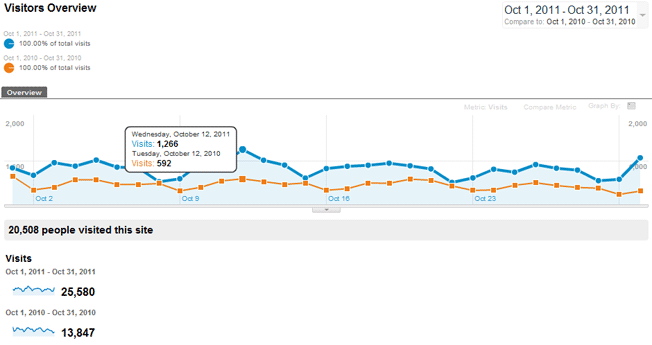
Remember that not everyone is as familiar with analtyics technology as you are, so highlight the most importnat pieces of data and provide context to why it matters.
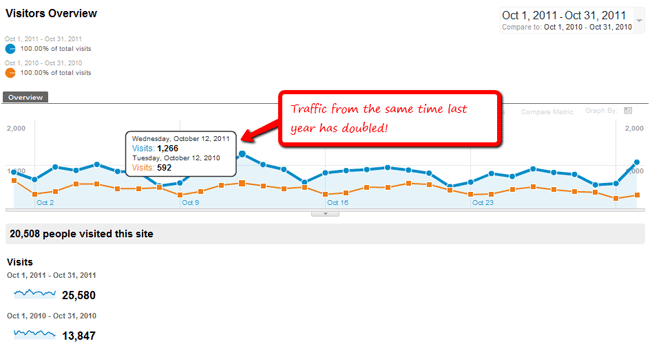
This way, the reader can see where the customer began and where the customer ended up with your help.
Plus having the picture proof can help the reader envision exactly what you might do for them, making your case study that much more powerful.
5. Talk About Specific Strategies in Your Case Study
So you doubled a website’s traffic or sales, right? How did you do it? This is where you sell your products or services simply by saying which ones you used and how they led to the desired result.
Don’t just say “our online marketing services led to these results.” Instead, say something like, ” A three-month social media campaign focusing on Facebook & YouTube and five-month of link building campaign led to an increase in rankings, plus brand exposure led to these results.”
Don’t worry about giving away your secrets — the goal is to establish your brand as an industry leader and you need to show you know your stuff.
6. Try Different Content Formats
Case studies do not have to be fit into a story form every time. Try different types of case studies, such as an interview format where you have your clients answer the same questions mentioned earlier about what they do, their needs, their goals, and how you met them.
Quoting your customer in their own words will make the case study even more relatable to your ideal customer than you telling the story.
Infographics, webinars, and even podcasts can also be used to highlight case studies. Don’t get stuck in the same old text-only format — get creative and see what type of content your users respond to.
Here’s a case study example from Venngage that uses a brochure-style case study to highlight how Vortex was able to grow conversion. (Notice the results section that highlights specific gains.)
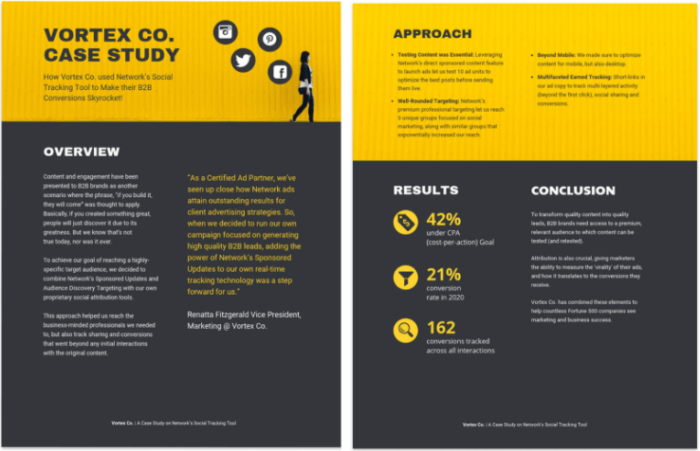
7. Appeal to Different Types of Learners
While some people enjoy reading, others may prefer audio, video, or visual representation of your case study. So consider taking your text-based case studies and re-purposing the content as:
- A podcast
- A YouTube video
- An engaging infographic (such as the one below)
The bonus with YouTube videos and infographics is that they are easy to share. This means that your case study may go further than just your own site, leading to more of your potential customers finding out how they could benefit from your products or services.
Case studies can also be embeded in other types of content — such as an ebook, how-to blog post, or resource guide.
8. Make Your Case Studies Easy to Find
What’s the point of having great case studies if no one will ever read them? Be sure that your case studies are organized and easy to find.
Here’s a few examples of good case studies that are easy to find — and therefore, much more powerful.
AWS provides case studies right on their homepage. They also make it easy to look for an-industry specific case study in manufacturing, financial services, fitness, and more.
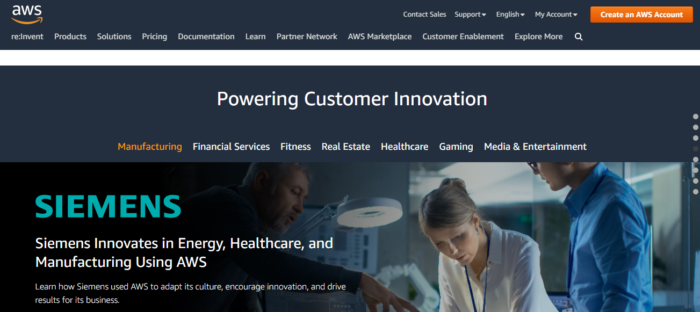
Drupal provides case studies right in their hero image. Users considering using their solution don’t have to look far at all to see how other brands are finding success with Drupal.
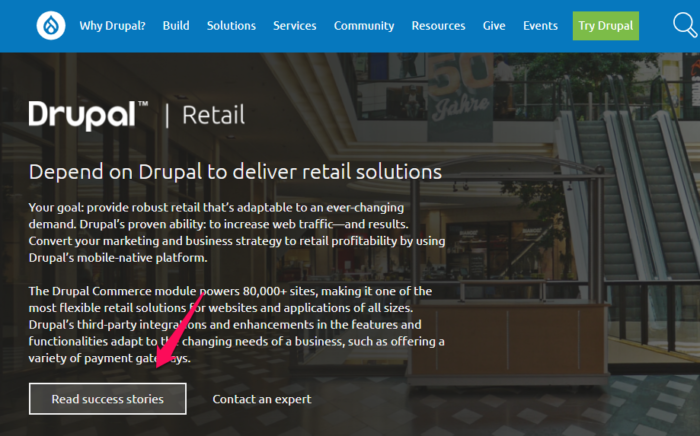
Conclusion
A great case study starts with case study research. Ask your customers to fill out a short form that highlights how you helped them reach their goals — be sure to ask for specific results.
Explain how the case study will help them by increasing brand awareness and link opportunities. Remember, a highly effective case study helps both you and your client build trust and reach a wider audience.
Have any case study best practice tips or examples of case studies you have enjoyed? Please share them in the comments!
The post 8 Tips For Creating a More Effective Case Study – With Examples appeared first on Neil Patel.
source https://neilpatel.com/blog/creating-a-great-case-study/





